Voyageur


“We don't see things as they are, we see them as we are.”
ANAÏS NIN

345 SEPTEMBER 2023
ISSUE
A CAPSULE OF THE WORLD

GasanZammit Motors Ltd., Triq il-Merghat, Zone 1, Central Business District, Birkirkara CBD 1020 Tel: 27788225 email: volvo@gasanzammit.com | www.volvocars.com.mt
The Volvo XC60
“Anything I can not transform into something marvelous, I let go. Reality doesn’t impress me. I only believe in intoxication, in ecstasy, and when ordinary life shackles me, I escape, one way or another. No more walls.”

Anaïs Nin
VOYAGEUR


“You have a right to experiment with your life. You will make mistakes. And they are right too. No, I think there was too rigid a pattern. You came out of an education and are supposed to know your vocation. Your vocation is fixed, and maybe ten years later you find you are not a teacher anymore or you're not a painter anymore. It may happen. It has happened. I mean Gauguin decided at a certain point he wasn't a banker anymore; he was a painter. And so he walked away from banking. I think we have a right to change course. But society is the one that keeps demanding that we fit in and not disturb things. They would like you to fit in right away so that things work now.”
Anaïs Nin

ON THE COVER:
THIS PAGE:
CREATIVE DIRECTOR AND SALES MANAGER SEAN ELLUL SELLUL@INDEPENDENT.COM.MT DESIGNER CONRAD BONDIN CBONDIN@INDEPENDENT.COM.MT PRODUCTION MANAGER ANDRE CAMILLERI ACAMILLERI@INDEPENDENT.COM.MT PUBLISHER STANDARD PUBLICATIONS, STANDARD HOUSE, BIRKIKARA HILL, ST JULIAN’S. TEL: 00356 2134 5888, WEB: WWW.INDEPENDENT.COM.MT FACEBOOK FIRSTMAGAZINE INSTAGRAM FIRSTMAGAZINEMALTA PRINTER PRINT-IT. FIRST IS PUBLISHED AS A COMPLIMENTARY MAGAZINE WITH THE MALTA INDEPENDENT ON SUNDAY AND IS NOT TO BE SOLD SEPARATELY. NO PART OF THE PUBLICATION MAY BE REPRODUCED WITHOUT THE PRIOR AGREEMENT OF THE PUBLISHER. FIRST MAGAZINE SINCE 1993. ISSUE NUMBER 345. EDITORIAL 3
Fontaine des Mers, Place de la Concorde, Paris, France. Photography Ozgur Kara.
Villa Ephrussi de Rothschild, Saint-Jean-Cap-Ferrat, France. Photography Hugo Richard.


Available at all Leading Pharmacies. Exclusively distributed by A.M.Mangion Ltd T: 23976000 W: www.relifecompany.com/ii/



CONTENTS 8 48 EXCLUSIVE SERIES: THIS IS WINE. Super
IV:
Tuscans
Super Tuscan Styles of Wine. Siena. Photograph Patrick Schneider
LA DOLCE VITA. Retreat into the Legendary Grand-Hôtel Du Cap-Ferrat, A Four Seasons Hotel.
THiS IS WiNE 18th chapter in this issue
Photograph© Christian Horan/Four Seasons.






82 INTERIORS.DesignersPaolo
[ISSUE 345. SEPTEMBER 2023] CONTENTS CONTENTS 20 43 GASTRONOMY.
Moschino and Philip Vergeylen. Photograph courtesy Vendome Press.
The Roux Brothers and Le Gavroche. Photo courtesy Le Gavroche.
MIXOLOGY. Negroni Fever. PhotographThomas Franke.
57 86 31
PRIDE AWARENESS. You’ve Come a Long Way Baby. Michelangelo, David.PhotographTaylor Smith.
WANDERLUST.
8 A DOLCE VITA Timeless Elegance on the Cote D’azur. Retreat to Saint-Jean-Cap-Ferrat. 20 INTERIORS An Entertaining Life. Designing Town and Country. 31 GASTRONOMY The Legendary Roux Brothers. Le Gavroche. 43 PRIDE AWARENESS You’ve Come a Long Way Baby. 48 THIS IS WINE The 18th Chapter in This is Wine Super Tuscans IV: Super Tuscan Styles of Wine. 57 MIXOLOGY Negroni Fever. Celebrating NEGRONI WEEK. 63 HEALTH & FITNESS Let’s Get Physical. Mind and Body. 64 HEALTH & WELLBEING World Alzheimer’s Month. SPECIAL FOCUS. Raising Awareness about Alzheimer’s Dementia. 75 ENVIRONMENT Environment and Climate Change. 78 BACK TO SCHOOL Backto School Anxiety. Teaching Children the Lifelong Skill of Money Management. 82 WANDERLUST Inside a Fairytale. Fabulous Château Chambord. 86 ICONIC Falling in Love with Laura. A Mystery in Marble.
ICONIC. Enigmatic Renaissance Masterpiece. Francesco Laurana, Bust of a Woman, Kunsthistorisches Museum Vienna, Kunstkammer.
Inside
a
Fairytale. Fabulous Château Chambord. Photograph Domaine National de Chambord Castle © Leonard de Serres.
RETREAT INTO THE LEGENDARY GRAND-HÔTEL DU CAP-FERRAT, A FOUR SEASONS HOTEL


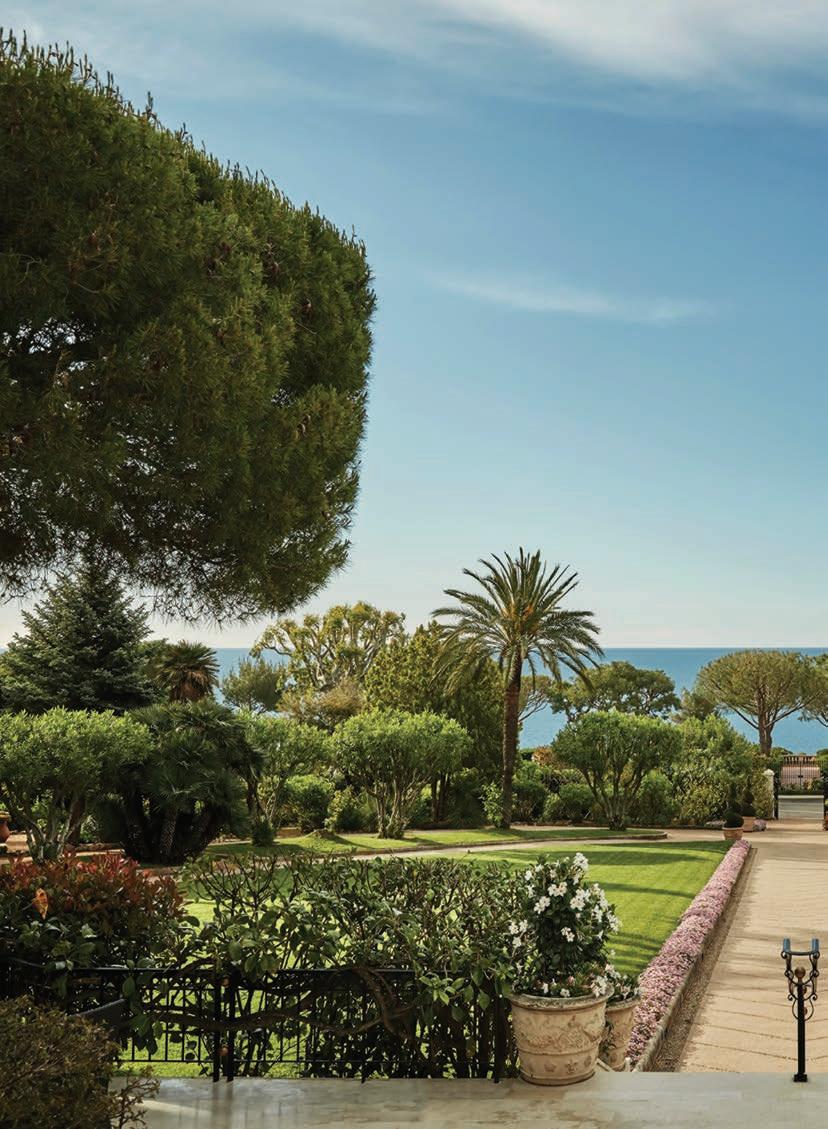
TIMELESS ELEGANCE ON THE COTE D’AZUR
At the turn of the 20th century, midway between Nice and Monte Carlo, the tip of the isolated Cap Ferrat peninsula in southeastern France was little more than a wilderness of rocks and dense scrubland jutting out from the French Riviera. In the late nineteenth century, King Leopold II of Belgium acquired the only wooded area of the Cap and bought the majority of vacant land. Shortly before 1900, Leopold sold a portion of his property to a company founded by Mr “Péretmère”, the son of a northern coachman and in 1908 construction began on what would become the magnificent Grand-Hôtel du Cap-Ferrat, with the two open angle wings. At the time, the building was seen as incomplete by many and the following year was given additional amenities including a dining loggia and a large central rotunda designed by the iconic architect Gustave Eiffel, who spent his winters in neighbouring Beaulieu-sur-Mer. Remarkably simple for its time, today, the classicism offers a striking modernity. Fast forward through the First World War, the Great Depression and the Second World, and the Grand-Hôtel du Cap-Ferrat would be on the cusp of a new holiday lifestyle with sun seekers flocking to its oasis – its guestbook signed by everyone from Charlie Chaplin, Picasso and Elizabeth Taylor to Winston Churchill and Aristotle Onassis.
Photography courtesy Four Seasons.

8 LA DOLCE VITA
This
page: Panoramic sea view terraces. Photograph © Christian Horan/Four Seasons.
“The majority of (painters), because they aren’t colourists, do not see yellow, orange or sulphur in the South of France, and they call a painter mad if he sees with eyes other than theirs.”
Vincent Van Gogh

LA DOLCE VITA 9
LA DOLCE VITA

In the nineteenth century the French Riviera was almost exclusively frequented by luxury tourists who came for long winter stays, including royalty from the north, like Queen Victoria and her court, and many aristocratic families. However around 1930, a handful of unconventional individuals, mostly writers and avant-garde artists, began exploring the French Riviera during the summer in search of tranquility. During summer of 1933, German filmmaker GW Pabst persuaded Russian opera singer Feodor Ivanovich Chaliapin to film Don Quixote at Cap-Ferrat – its Moorish landscape perfectly suited the movie’s need and filming in Spain was not possible. Consequently, cast and crew arrived unexpectedly and secured accommodation at the closed Grand-Hôtel du Cap-Ferrat for a few weeks. While accommodation was improvised, actors and technicians were delighted to stay in such a corner of paradise. The following year, many of them wished to return independently, marking the modest beginnings of the summer season in Saint-Jean-Cap-Ferrat.

10

11 LA DOLCE VITA
This page: Constructed in 1939, the 33-metre pool has been a glamorous destination ever since, drawing world-famous actors, artists, writers and politicians to its infinity edge and sunbathed views. Photograph © Christian Horan/Four Seasons.
Younger and more athletic than their predecessors, this new generation of vacationers was seeking sun and water, but because of the rocky tip of the Cap, the sea was not easily accessible. To address this, a cove was created by removing rocks and cliffs, with the aim of constructing an Olympic-sized seawater swimming pool near the shore, however masonry contractors were hesitant to build a reinforced concrete tank measuring over thirty metres in length and twelve metres in width, given its exposure to varying temperatures and outdoor elements. This engineering feat would eventually become a source for one of the property’s most captivating stories. Construction of the pool was eventually entrusted to a recently established company in Cap-Ferrat, led by an Italian bricklayer who possessed a surprisingly advanced level of technical expertise for the size of his company. In 1939, this Italian bricklayer astonished the hotel management by designing and constructing the hotel’s structurally intricate waterfront pool in just one day – indeed today, the Club Dauphin pool still remains a standout feature among the hotel’s many amenities and is accessed via a private glass funicular.



LA DOLCE VITA 12
This page: Nestled in 17 acres of lush gardens on the rugged SaintJean-Cap-Ferrat peninsula, the Grand-Hôtel du Cap-Ferrat, A Four Seasons Hotel, has been a French Riviera destination since 1908. Photography above and left © Christian Horan/FourSeasons, bottom © Manuel Zublena/Four Seasons.
BRIC'S MILANO EXCLUSIVELY AVAILABLE AT PORTO.

Italian handmade quality since 1952. Premium leather goods and artisanal workmanship. This is the craftmanship of Bric’s. Taking care of what is precious to accompany every traveller through time.
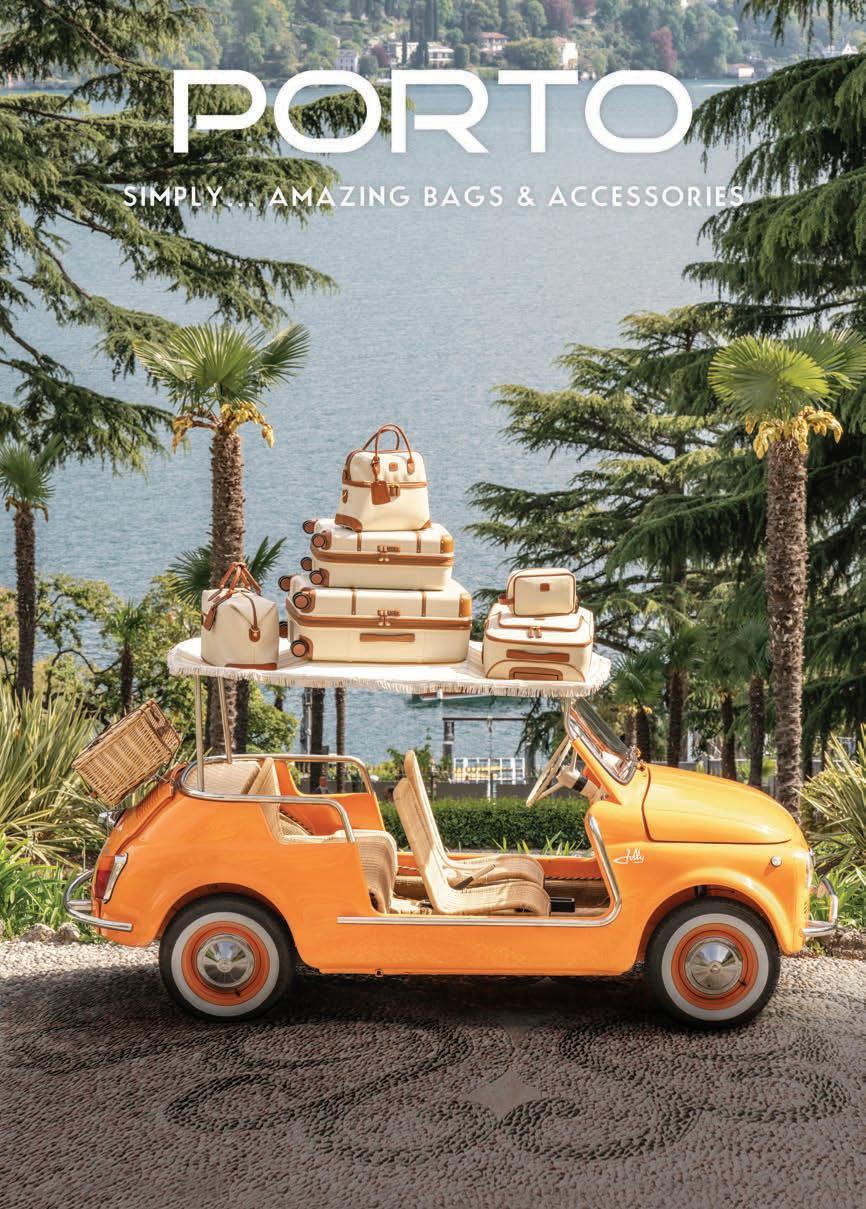
PORTO BOUTIQUE HILTON MALTA, ST. JULIAN’S AND DOLMEN HOTEL QAWRA FACEBOOK.COM/PORTOHANDBAGS WWW.PORTOMALTA.COM
Several years after building the pool, during the World War II Italian occupation of the Côte d’Azur, the same bricklayer returned to the hotel, now in a dashing military uniform, and remarked to the manager, “Nice to see the pool held up.” The simple bricklayer had been an Italian spy who had used the hotel’s prominent clients as a source of intelligence. What could be a better way to locate and identify, without attracting attention, military sites and positions, than being a brick-layer on the coast?

Just a few weeks after this unexpected encounter, the hotel would close its doors, paint its windows blue, and remain shut for an extended sixyear period. On March 5, 1944, the entire peninsula faced evacuation and was heavily mined in anticipation of a military invasion. Surprisingly, the iconic hotel and its pool remained untouched by the nearby artillery shells and the explosion that demolished the lighthouse. After the war, the hotel underwent several changes in ownership before its transformation into the Grand-Hôtel du Cap-Ferrat, A Four Seasons Hotel.

LA DOLCE VITA
Above: Jutting out into the Mediterranean Sea, the peninsula offers a stunningly rugged landscape to immerse in nature and disconnect from everyday life.
14
Photograph © Christian Horan/Four Seasons. Bottom: Ride the glass funicular down to the Club Dauphin Pool and you’re arriving at a Côte d’Azur landmark. Photograph © Four Seasons.




LA DOLCE VITA 16
Today the Grand-Hôtel du Cap-Ferrat, A Four Seasons Hotel is a rare and exquisite seaside retreat on the Côte d’Azur, set amidst 17 acres of lushly landscaped gardens with panoramic views of the Mediterranean. The Hotel features 74 guestrooms including 24 suites, and a private villa –Villa Rose Pierre, an award-winning Spa, fine and casual dining restaurants and one of the most beautiful pools in the world. The Hotel completed its 100th anniversary in 2009 with an extensive expansion project that celebrates the grandeur of the past. The renovation project began in 2007 when the acclaimed landscape designer Jean Mus added his touch to the Grand-Hôtel’s gardens: seven hectares of verdant, blossoming and flawlessly manicured seafront gardens rolling down the impeccable lawn to the dramatic coastline. Rare trees, exotic plants, and

richly fragranced Provençal flora bloom in shades of soft pastels along winding walkways that lead down to the rocky sea shore. Paris based Pierre-Yves Rochon led the design of the hotel, restaurants, guest rooms and the interior design of The Residence: a new wing designed by architect Luc Svetchine.
On the ground floor of the hotel, a salon, Le bar and the restaurant La Véranda were created besides the Rotunda. On the garden level, the gastronomic restaurant Le Cap awarded one Michelin star is open every evening in the mid and high season, and closer to the sea, the legendary Club Dauphin restaurant with its Olympic pool. The hotel's Salon des Collections also holds one of the world’s most spectacular wine collections including 141 vintage bottles of Château D’Yquem dating back from 1854 (1854 – 2003) and 33 bottles of Château Lafite Rothschild wines dating back from 1799 (1799 – 1899).

LA DOLCE VITA 17
Above: The original Rotunda, with magnificent views through its bay window, was imagined and built by iconic architect Gustave Eiffel in 1909. Photograph © Christian Horan/Four Seasons Left: The sparkling waters of a private infinity pool rival the blue of the nearby Mediterranean Sea in a Four Seasons Pool Suite. Photograph © Christian Horan/Four Seasons.
The most prominent design elements are intended to provide the experience of living in a well appointed home. The use of beige Persian marble and white Calcutta cream marble throughout rooms and public spaces in addition to exquisite fabrics of white linen, natural silks in pastels and tones of beige and white maximize the effect of an abundance of sunlight, spectacular views of the sea and surrounding gardens.
While the rooms and suites were carefully redecorated in order to follow modern palace standards, the design is classic French reminiscent of the Riviera of the 1940’s and 1950’s. More than a century after it first opened, the Grand-Hôtel du Cap-Ferrat, A Four Seasons Hotel still attracts vacationers seeking a tranquil sun-filled and water-rejuvenating corner of paradise. Jutting out into the glistening blue waters of the Mediterranean Sea, the peninsula offers a stunningly rugged landscape to immerse in nature and disconnect from everyday life. And if you’re seeking livelier nightlife after a peaceful day of relaxation, a quick dash to Monaco –just minutes away – is a must for young and the restless.

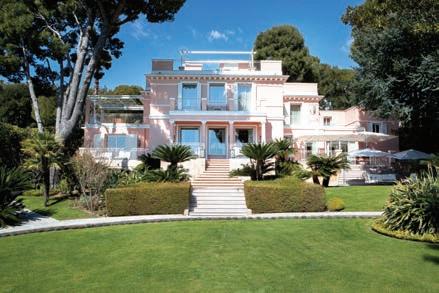

LA DOLCE VITA 18
Above and left: Tucked away among the pines, Villa Rose Pierre, a private villa at the Grand-Hôtel du Cap-Ferrat, A Four Seasons Hotel.
Photograph © Gregoire Gardette/Four Seasons.
Bottom left: Le Spa is a haven of peace and tranquility, uniquely situated at the tip of the peninsula of Cap-Ferrat, overlooking the Mediterranean. Set amidst seventeen acres of fragrant Provençal gardens.
Photograph © Manuel Zublena/Four Seasons.

“Someone once told us that if you see something you like and you can afford it, buy it. It is always the things you don’t buy, not the ones you do, that stir up regret. Shopping this way leaves one open to surprises. We never go out looking for specific pieces, with their place already picked out and tape measure in hand. Rather, it is the ability to change plans, or to spot something when you’re not looking, that has helped us find some excellent things.”
PAOLO MOSCHINO AND PHILIP VERGEYLEN


INTERIORS 20
JOIN TWO OF THE WORLD’S MOST CELEBRATED DESIGNERS, PAOLO MOSCHINO AND PHILIP VERGEYLEN, AS THEY SHARE THE INSPIRATIONS AND STORIES BEHIND THEIR LIFE AND WORK IN LONDON, THE ENGLISH COUNTRYSIDE, AND BEYOND
AN ENTERTAINING LIFE DESIGNING TOWN AND COUNTRY
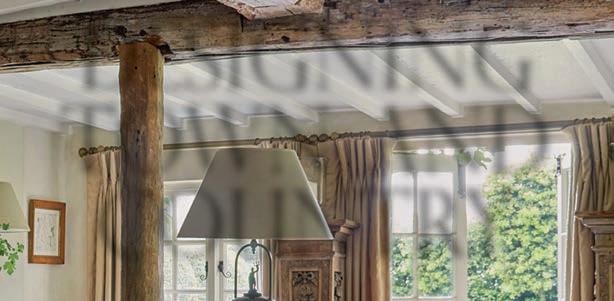


After nearly thirty years together, mixing professional and personal lives, every day is still a surprise for design gurus Paolo Moschino and Philip Vergeylen. Chronicled in the pages of an inspiring new publication, An Entertaining: Life Designing Town and Country published by Vendome Press, are their own houses in London and Sussex alongside client projects – from a Balinese-style compound in the Caribbean to a palatial villa in Sicily. Several chapters are devoted to their country home, which has become their base – not just a weekend escape for relaxation, but a home filled with collections, an office, and a series of formal gardens that has proven perfect for entertaining. Nestled between pages of stunning imagery from some of the design world’s best photographers, Moschino and Vergeylen include engaging stories and anecdotes, recipes from their favorite dinners and notes on their celebrated design philosophy. The pages share an intimate look at their peripatetic lives filled with beauty, adventure, and the unexpected.
Photography courtesy Vendome Press.

INTERIORS 21
“Paolo Moschino and Philip Vergeylen are two extraordinary interior designers,“writes interior and garden designerBunny Williams, in the introduction to their new book An Entertaining: Life Designing Town and Country. “The special combination of Paolo, who is Italian, and Philip, who is Belgian, and the fact that they live in England, has made for completely unique and personal spaces. As you pan over the pages, you can imagine them traveling the world finding the furniture, objects, and textiles that fill each room, and you wish you were traveling with them. You then can study the artful arrangement of furniture, the creative small still lifes, and the use of fabrics and textiles that all blend together without feeling decorated. This is a unique skill. Each room is so luxuriously and comfortably assembled that, as a guest, you never want to leave.”


22 INTERIORS

“Entertaining is a big part of our lives –entertaining friends is our pleasure, while entertaining clients is part of our job to understand their needs and to translate their dreams into reality when we create the homes they desire,” write Paolo and Philip. “However, for us, the entertainment continues even when it is just the two of us. We have known each other for almost thirty years, and we have worked together for almost twenty, so we need to entertain each other to keep going strong together!“



24 INTERIORS

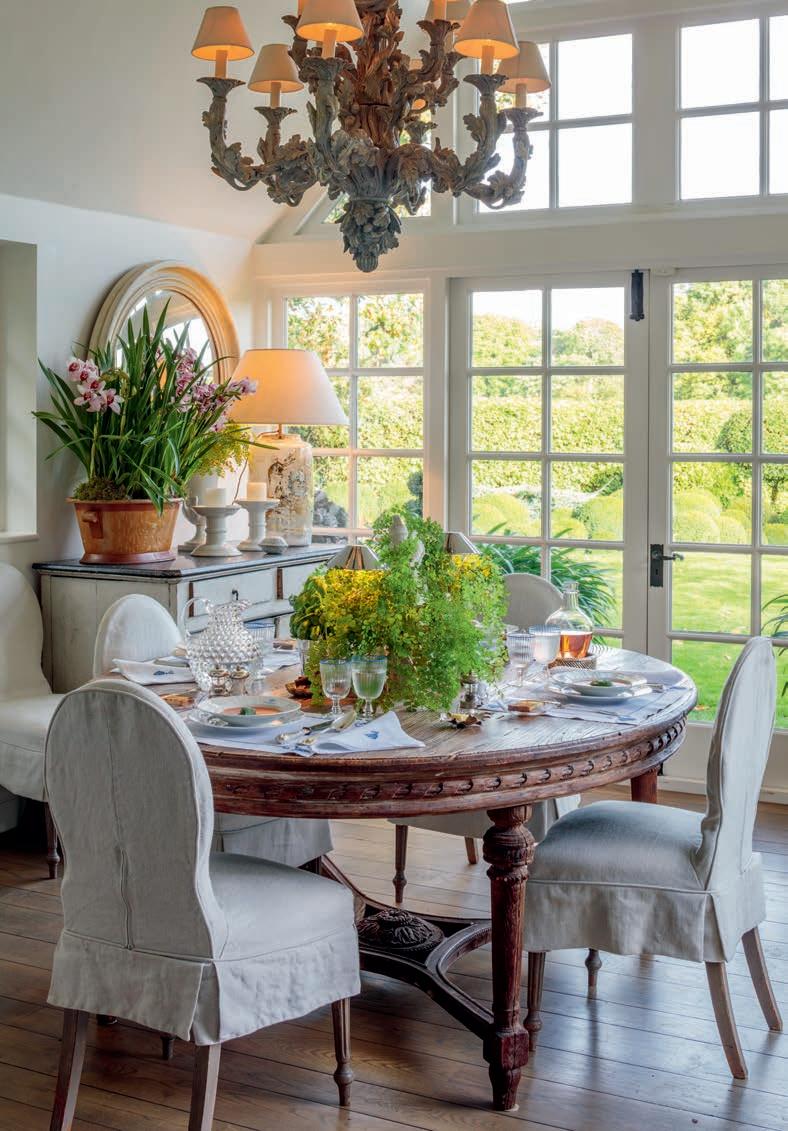
26 INTERIORS
“Travel is a strong source of inspiration and pleasure for both of us; inspiration can be found in the most random of places, from a street market in India to the Met in New York. We often buy little things at museum gift shops– and we have also been known to carry back with us a thirty-six-piece dinner set from an antique store in East Hampton!“
“It could be said that buying beautiful objects is a bit of an addiction of ours. Philip especially loves to buy china, glass, silver, and any other accessories required to create our theatrical table-settings. You could stay with us for a month and never eat twice from the same plate or drink twice from the same glass.“


“We bought the house in Sussex about twelve years ago and had very grand ideas for it, treating the cottage like a big country house. The garden is growing and improving every year, while all the interiors reflect how our passion for design is liberally sprinkled with a sense of fun.“
On their first visit to Sussex, Paolo and Philip fell in love with the area. They had been invited to lunch, and the picturesque countryside, sunny weather, and their host’s charming Tudor house were compelling. Paolo and Philip had been living in London but were looking for something in the countryside and by the end of lunch were convinced that West Sussex was the place for them. After lunch, they visited a local real estate agent and made an offer on a stable block- although the offer would fall through,it cementedtheir desire for a country house in Sussex.
INTERIORS 27
“After twenty-five years together, mixing professional and personal lives, we have become good at making these types of decisions together quickly. We spent almost a year looking... Philip, especially, was poring through the listings– and he found a property that ticked every box. We arrived ten minutes early
for our appointment with the real estate agent. Peering over the garden gate we saw a house covered with vines, while behind an old, somewhat dilapidated barn we could see a sunny pasture with a smattering of sheep. When the agent arrived, we told him we’d take it. “But you haven’t even seen it!” he replied. To us, however, the house was already ours.”
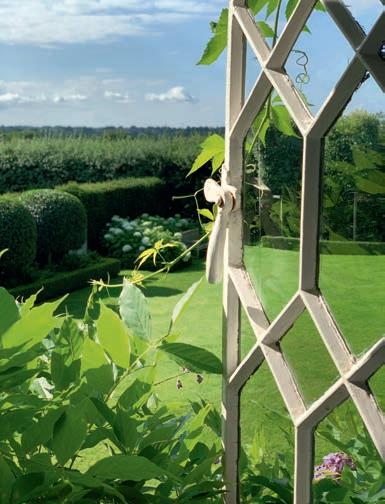
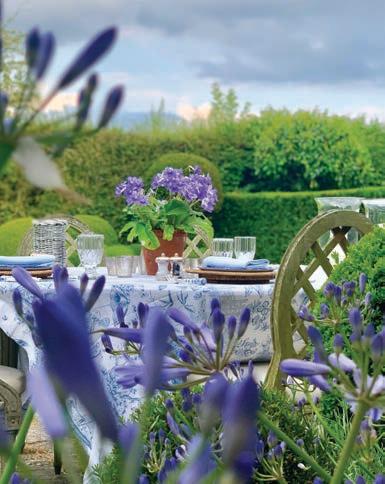
ABOUT THE AUTHOR. Born and raised in Italy, Paolo Moschino came to London at the age of 23 and never left. He now leads the award-winning firm Paolo Moschino Ltd, which has become an international brand encompassing interior design, furnishings and fabric. With three interior design showrooms in London, the firm continues to evolve. Moschino’s partner, Belgian born Philip Vergeylen, helms the company’s Design Studio, and is now recognized around the world as a leading voice in luxury interior design. They divide their time between London and Sussex. Bunny Williams is a world renowned interior and garden designer, and the author of several books. She divides her time between Connecticut and Punta Cana.
AN ENTERTAINING LIFE: DESIGNING TOWN AND COUNTRY by Paolo Moschino and Philip Vergeylen. Foreword by Bunny Williams. Published by Vendome Press. Hardcover with jacket. 256 pages, 250 colour illustrations.


28
INTERIORS

The iconic Spanish treat, now available in Malta



Handmade since 1910 with 100% natural ingredients –wheat flour, premium quality extra virgin olive oil, sugar, and aromatic spices, each one of Inés Rosales' Oil Tortas is unique and unrepeatable thanks to the delicate hands that shape it before baking.

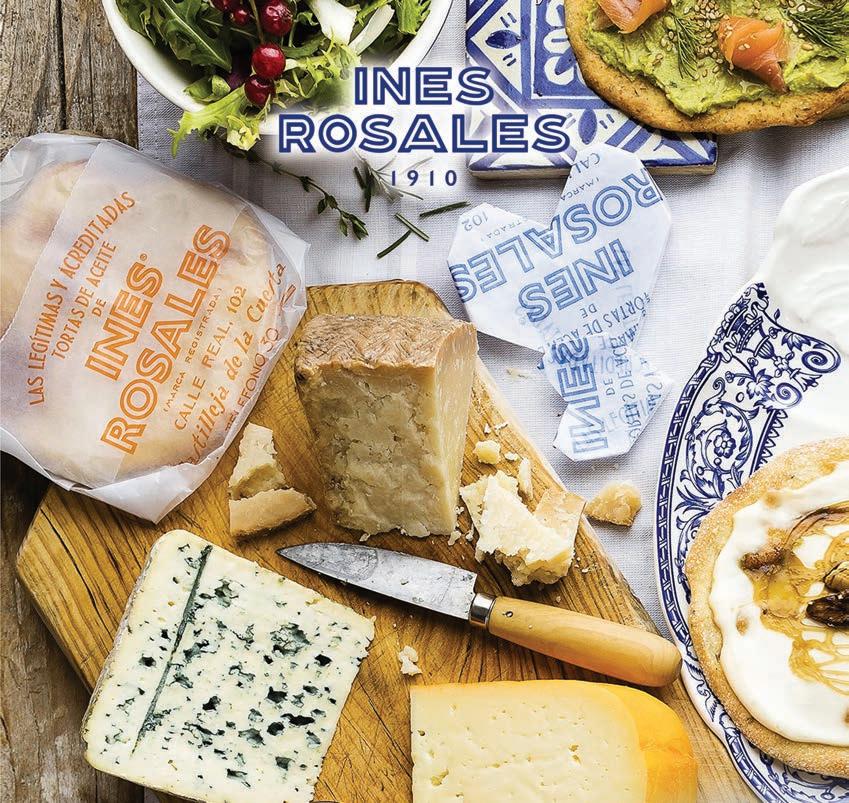
INÉS ROSALES’ OIL TORTAS
Trade Enquiries Santa Lucia Gourmet Wines Gifts, Triq Il-Linja, Attard Tel: 2141 7894, email: info@santaluciacafe.com
THE LAST BASTION IN LONDON OF CLASSICALLY RICH FRENCH HAUTE CUISINE
THE ROUX BROTHERS LE GAVROCHE

Le Gavroche (The Urchin) is a restaurant at 43 Upper Brook Street in the heart of Mayfair, London. It was opened by the legendary Roux brothers, the late Albert Roux OBE and Michel Roux Sr OBE, in 1967 at 61 Lower Sloane Street, its premises until 1981. Albert’s son Michel Roux Jr is the current chef patron. Le Gavroche is an industry titan and its influence on the UK hospitality scene cannot be overstated – it was the very first restaurant in the UK to be awarded, one, two, and then three Michelin stars – which it held from 1982 to 1993. Known as “the last bastion in London of classically rich French haute cuisine,” the restaurant today holds two Michelin stars (the longest restaurant in the UK to do so), alongside a host of honours, spanning from inclusion in various World’s 50 Best lists to the Laurent Perrier Award of Excellence, Tatler Restaurant Awards – Most Consistently Excellent Restaurant, and a Lifetime Achievement Award for its Chef Patron, Michel Roux. Le Gavroche is internationally recognised for its culinary excellence, illustrious pedigree, and inimitable guest experience, and for over five decades has remained an iconic figure.
Photography courtesy Le Gavroche.

GASTRONOMY 31
This page: Michel Snr (left) and Albert opened Le Gavroche in 1967 at 61 Lower Sloane Street, its premises until 1981. Photography Le Gavroche.
“Good food is the foundation of genuine happiness.” Auguste Éscoffier
Over the course of half a century, the Roux family’s influence and reputation for incomparable French fine dining has taken London’s dining scene from almost non-existent to cementing it one of the food capitals of the world. As a London institution, Le Gavroche has attracted some of the finest UK and international culinary talent to its kitchen, including the likes of Gordon Ramsay, Marco Pierre White, Marcus Wareing, Pierre Koffman, Monica Galetti, Jun Tanaka, Bryn Williams, Phil Howard, Stephen Terry, Rowley Leigh, Paul Rankin, and Brian Maule.
Albert Roux was born 8th October 1935, in Charolles, France. He was the son of a charcutier. His brother Michel was born 19th April 1941. Both brothers began their culinary journey by training under various renowned French chefs. The brothers opened Le Gavroche together in 1967, marking the beginning of their culinary success in London. Its name comes from the character Gavroche in Victor Hugo’s Les Misérables, a kind street urchin who lives on the streets of Paris, desperate for a warm house and a good meal.

GASTRONOMY 32
Above: Chef Michel Roux Jr outside Le Gavroche, at 43 Upper Brook Street in the heart of Mayfair. Photography Jodi Hinds.
your luxury moment.
LIVE LIFE THE GRAND WAY WITH MALTA’S GRAND WINE. GRAND VIN DE HAUTEVILLE
 BY MALTA’S FOREMOST WINERY.
BY MALTA’S FOREMOST WINERY.

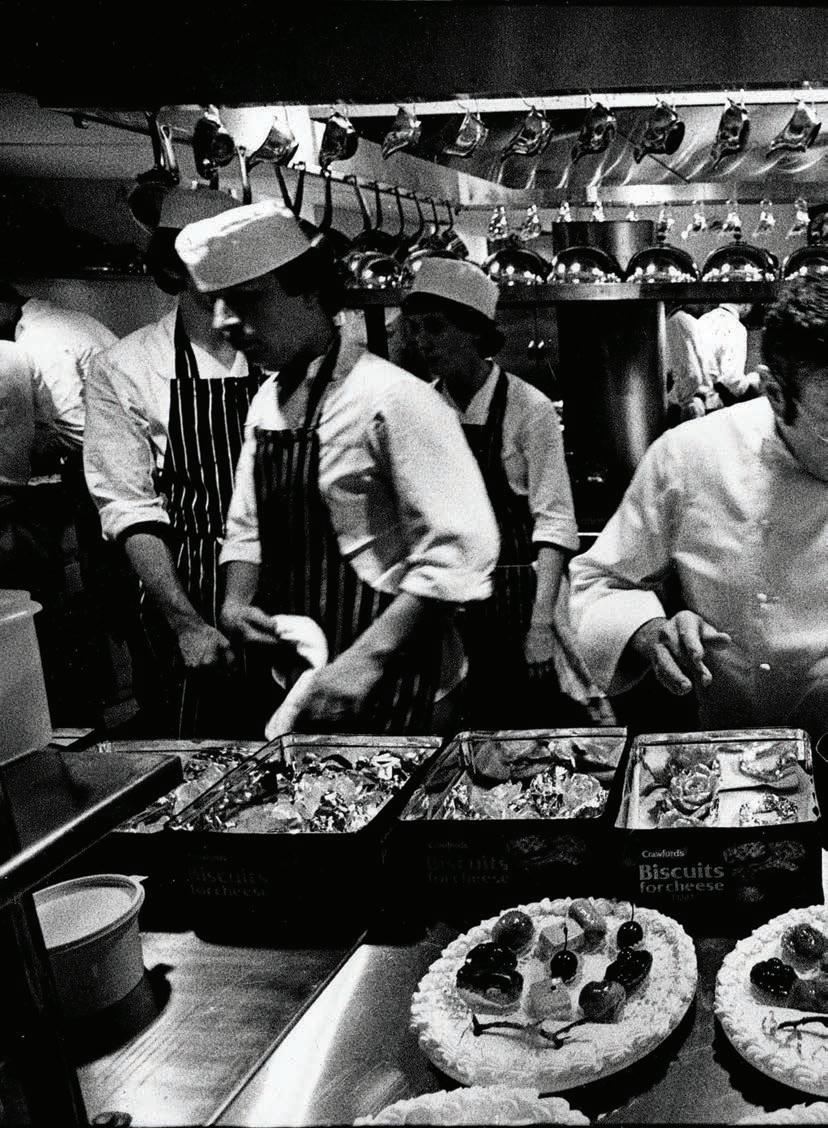
GASTRONOMY 34


GASTRONOMY 35
This page: The legendary Roux brothers Albert (centre) and Michel Snr (right) in the kitchens at Le Gavroche. Photography Le Gavroche.
In 1982 Le Gavroche became the first restaurant in the UK to earn three Michelin stars, setting a new standard for fine dining in the country. The Roux brothers also established The Waterside Inn in Bray, Berkshire, which also achieved three Michelin stars. In addition to their restaurants, the Roux brothers made significant contributions to culinary education in the UK. They established the Roux Scholarship, a prestigious cooking competition for young chefs. In 1986 the brothers split their restaurant business between them, Albert took Le Gavroche, while Michel took the Waterside Inn, which is currently run by his son, Alain.



GASTRONOMY 36
Above: Chef Michel Roux Jr has been at the helm of Le Gavroche since 1991. Photography Jodi Hinds.
Above: The intimate bar at Le Gavroche, a place to enjoy a drink before your meal. Photography Issy Croker. Bottom left: Inside the main dining room of Le Gavroche restaurant. Photography Issy Croker.













COME VISIT US FOR AN unforgettable experience Reservations for winery visits & tastings by email at events@meridiana.com.mt TRADE ENQUIRIES Wine & Spirits Merchants Stadium Street, Gzira, GZR1301 Tel: +356 2133 0447 • Mob: +356 7909 3197 • Email: info@srausi.com www.srausi.com Ta’ Qali, ATD4000 Tel: +356 2141 3550 • Email: info@meridiana.com.mt www.meridiana.com.mt Meridiana Wine Estate
This August Chef Michel Roux Jr, who has been at the helm of the restaurant since 1991, surprised the culinary world with the announcement of the upcoming closure of Le Gavroche. After 56 years, the restaurant will close its doors in January 2024. “This decision has not been made lightly. Le Gavroche means so much, not just to myself and the Roux family, but to the wider Gavroche team and our guests who have become family over so many years,” says Michel. “The end of the current lease gave me the opportunity to assess and consider the future, and I’d like the restaurant to close on a high. It’s about turning the page and moving forward so I can focus on my family and other business ventures. This is not the end of Le Gavroche – the restaurant may be closing, but the name will live on, as will the Roux dynasty.”


The closure at Upper Brook Street will also allow Michel more time to concentrate on the other Roux businesses, including Chez Roux –famed for its stunning hospitality at prestigious sporting events, it has expanded to offer unparalleled catering at home or chosen venue as well as cookery classes and culinary consultancy. Michel will continue to operate the Le Gavroche brand for special events and pop-ups, and will also continue to write cookbooks and create television series.
Guests at Caractère, the restaurant belonging to Michel’s daughter Emily Roux and husband Diego Ferrari, will also be able to experience Michel’s cooking at special events. “I am pleased to have made this decision and excited to take Le Gavroche on the road, to be a master of Le Gavroche rather than it being my master,” says Michel. Over the course of the next few months, Michel and the team at Le Gavroche will be hosting a series of exclusive events to ensure the restaurant goes out in style. The dinners, which will commence in November and run through until the restaurant’s closure in January next year, will be open to the public and will celebrate the restaurant’s menus throughout the years.

GASTRONOMYA 38
This page (clockwise): Le Gavroche Butter Poached Lobster Tail, Le Gavroche Lamb Cutlets with Courgettes, and Le Gavroche Strawberry Shortbread. Photography Jodi Hinds.

Soufflé Suissesse
TAKEN FROM MICHEL ROUX JR’S LE GAVROCHE COOKBOOK, WEIDENFELD & NICOLSON. The thought of making a soufflé can be intimidating for even the most skilled home cook, however this signature recipe from Michel Roux Jr’s Le Gavroche –on of the restaurant’s most famous dishes –is worth trying. Soufflé Suissesse is a splendid representation of opulent classical French cuisine at its finest. It’s crucial to use the finest quality eggs (preferably good free range or organic eggs), milk, cream, and butter to elevate this dish

SERVES 4
45g butter
45g plain flour
500ml milk

5 egg yolks

salt and freshly ground white pepper
6 egg whites
600ml double cream
200g Gruyère or Emmental cheese, grated

1. Heat the oven to 200C/400F/gas mark 6. Melt the butter in a thick-based saucepan, whisk in the flour and cook, stirring continuously, for about a minute. Whisk in the milk and boil for 3 minutes, whisking all the time to prevent any lumps from forming.
2. Beat in the yolks and remove from the heat; season with salt and pepper. Cover with a piece of buttered greaseproof paper to prevent a skin from forming. Whisk the egg whites with a pinch of salt until they form firm, not stiff, peaks.
3. Add a third of the egg whites to the yolk mixture and beat with a whisk until evenly mixed, then gently fold in the remaining egg whites. Spoon the mixture into four well-buttered 8cm diameter tartlet moulds and place in the oven for 3 minutes, until the tops begin to turn golden.
4. Meanwhile, season the cream with a little salt, warm it gently and pour into a gratin dish. Turn the soufflés out into the cream, sprinkle the grated cheese over them, then return them to the oven for 5 minutes.
5. Serve immediately.

GASTRONOMY 40
Photography this page Issy Croker, courtesy Le Gavroche.
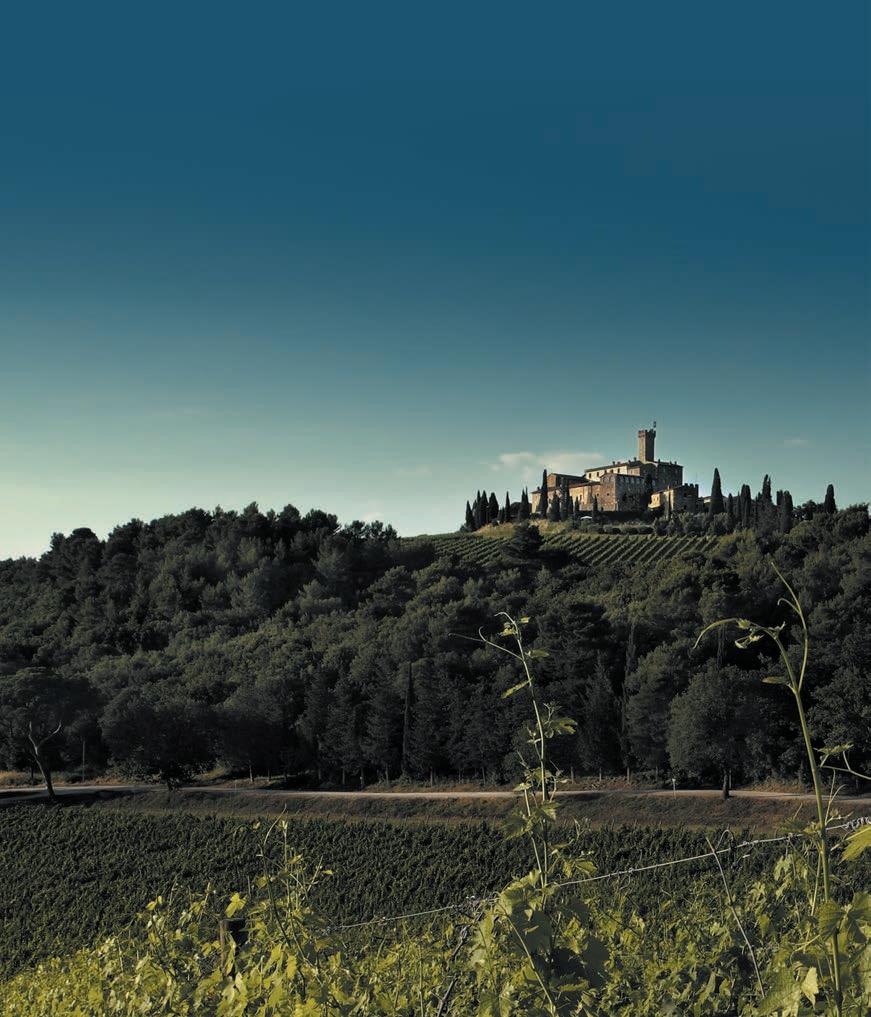



31 Oct - 5 Nov 202310 - 11 Nov 2023 11 - 28 Jan 20249 - 13 Feb 2024 14 - 16 March 2024 4 May 2024 24 - 25 May 2024 August 2024 8 - 13 July 2024 25 - 28 July 2024 7 Oct 2023 14 - 23 June 2024
festivals.mt
CELEBRATING THE PAST, CREATING THE FUTURE
YOU’VE COME A LONG WAY BABY




According to the ILGA Europe Rainbow Europe index Malta is the best place in Europe for LGBTIQ+ people, in fact legislatively Malta is far ahead of many other European nations. Having anti-discrimination laws introduced in the Maltese Constitution in 2014 was definitely one high point in the development of equality for the LGBTIQ+ Community in Malta, and ILGA-Europe have ranked Malta first place in its annual review of the human rights situation of LGBTIQ+ people in Europe since 2016 - with 91 points out of 100, it is seventeen points ahead of second-placed Denmark.
But changes in Maltese law started in the 1970s. In 1973 the Government decriminalised male homosexuality and harmonised age of consent against a strongly opposing, but still influential Roman Catholic Church as well as the Nationalist Party in opposition. Since then, several important milestones were reached that brought Malta’s LGBTIQ+ rights up to the highest standards.
In 2002 LGB people were allowed to serve openly in the military. In 2004 anti-discrimination laws were passed regarding employment. In 2012 hate crime provisions were extended to include sexual orientation and gender identity. In 2013 grounds were introduced for asylum protection, and a provision included that allows time on gender affirmation treatment to be counted as part of sick leave entitlements. In 2014 constitutional anti discrimination provisions for the grounds of sexual orientation and gender identity were introduced, as were recognition of same-sex couples and parenting rights including adoption through civil-unions. In 2015 the right to change legal gender was approved; also intersex minors became protected from normalising surgical procedures without informed consent; while hate crime and anti-discrimination provisions were extended to include gender expression and sex characteristics. In 2016 conversion therapy was banned. In 2017 marriage equality came into force, and a third-gender option on ID cards and passports was introduced. In 2018 access to IVF for lesbian couples and single persons was granted, and access to free healthcare for trans persons and setting up the of Gender Wellbeing Clinic. in 2019 MSM's were allowed to donate blood (under a one-year deferral period). As of 2022 all genders, irrelevant of sexual orientation, are allowed to donate blood.

Source: Europride Valletta 2023.
WHAT IS ILGA-EUROPE? ILGA-EUROPE IS THE EUROPEAN REGION OF THE INTERNATIONAL LESBIAN, GAY, BISEXUAL, TRANS AND INTERSEX ASSOCIATION. IT IS AN ADVOCACY GROUP PROMOTING THE INTERESTS OF LESBIAN, GAY, BISEXUAL, TRANS AND INTERSEX (LGBTI) PEOPLE, AT THE EUROPEAN LEVEL. ITS MEMBERSHIP COMPRISES MORE THAN 500 ORGANISATIONS FROM THROUGHOUT EUROPE AND CENTRAL ASIA.
PRIDE AWARENESS
This
page and overleaf: Michelangelo, David, Galleria dell'Accademia, Florence. Photography this page Taylor Smith, photography overleaf Lucas Calloch.
43
“It takes no compromise to give people their rights.” Harvey Milk
EQUALITY FROM THE HEART 7-17TH SEPTEMBER 2023
EUROPRIDE VALLETTA 2023
EuroPride is a pan-European international event dedicated to LGBTI pride, hosted by a different European city each year. The host city is usually one with an established pride event or a significant LGBTI community. EuroPride was inaugurated in London in 1992, and attended by estimated crowds of over 100,000. Madrid's EuroPride 2007 was the most well-attended event at the time, with an estimated 2.5 million visitors. This huge attendance was not only a success for Madrid, but for the whole LGBTI Spanish community, due to the celebration of the change of terms in the laws related to gay marriage and adoptions. In 2020 five bids to host Europride were submitted to the European Pride Organisers Association- Malta Pride won with 54% of votes (vs Belfast 29%, and Rotterdam 18%).
PWHY IS PRIDE AWARENSS STILL IMPORTANT?


ride awareness remains important in a country like Malta, despite its high ranking on the ILGA Europe Rainbow Europe index, because it helps maintain and advance the progress made. It reinforces inclusivity, educates against complacency, and serves as a global example of LGBTIQ+ rights and acceptance. Continued awareness ensures that the positive environment is preserved and can inspire other countries to follow suit. Ultimately, even if there is just one adult or child being bullied in one family by family members, or in one classroom by classmates or teachers, because of their orientation or gender, Pride Awareness and education will remain important.

PRIDE AWARENESS 44

The Continuous Struggle to Achieve a Fairer, Better, and More Equal Society
Traditionally Malta was considered as the most conservative and homogeneous country in Europe strongly embedded in its Roman Catholic roots. Starting with the referendum on divorce in 2011, the country has embarked on a path that recognizes that some cohorts in society have different needs and aspirations from the norms and values that are deemed “right” by the prevailing culture, writes MEP Alex Agius Saliba.
The push for greater equality was multi-faceted; various sectors of society voiced their frustrations about practical and legal obstacles they encountered in their struggle to have a fair and equal chance of prospering in their life and to enjoy their life without hindrance. The Government has wisely taken these concerns on board and enacted a raft of legislative reforms. Legislation about sexual orientation is well publicized but reforms which provided equal opportunities for individuals with physical and mental health issues are just as important. The reforms have brought us on par with other countries in Europe and, in some areas, Malta is now avant-garde.
In 2016 Malta became the first European country to ban gay conversion therapy. Similar bans have since been adopted in Germany, France, and several northern European countries. Malta is ranked first in Europe for LBGTIQ protection and human rights.

The Government’s work is in sync with similar reforms being adopted by the European Parliament. During the last few years in my role as MEP I foresaw and negotiated the introduction of measures to promote the rights of victims of sexual abuse, deaf individuals, and autistic persons. The struggle to promote an equal and fair world continues.


Individual needs evolve together with society, and it would be utopian to say that we may ever reach a point where the specific needs of all individuals would have been catered for. Future challenges will include how to ensure equality for specific cohorts within the already identified distinct cohorts. Another delicate matter will be to ensure that archetypal members of society do not feel engulfed or threatened by the promotion of equality for all.
I believe that with a more focused effort by the stakeholders involved, we may further enhance the work done in the last years to promote equality and ensure that all individuals have a fair opportunity to achieve their aspirations.
E: alex.agiussaliba@europarl.europa.eu M: +356 7943 5702
One of the myths surrounding the LGBTIQ+ community is that intimate partner violence is not a common issue for LGBTIQ+ couples, however, the prevalence rate of abuse in samesex relationships is as high as the rates experienced by heterosexual couples. This in fact reflects on the individuals’ experiences of reporting, as they fear that they would not be believed or ridiculed.
THE FEAR OF COMING OUT & SAME-SEX INTIMATE PARTNER VIOLENCE
LGBTIQ+ people are at a great risk of experiencing gender-based violence and domestic violence especially when considering that binary gender stereotypes and norms are still prevalent in our society writes Samantha Pace Gasan, Commissioner for Gender-Based Violence and Domestic Violence. To address these issues, the Commission on Gender-Based Violence and Domestic Violence hosted a community discussion during Euro Pride Valletta 2023. The discussion was moderated by the Commissioner on Gender-Based Violence and Domestic Violence, Ms Samantha Pace Gasan; and the panel involved professionals who are experts in the field: Ms Renee Laiviera, Commissioner for the Promotion of Equality; Dr Claire Azzopardi Lane, Deputy Dean within the Department for Gender Studies & Sexuality at the Faculty for Social Wellbeing at the University of Malta; Ms Colette Farrugia Bennett, Service Manager at the Domestic Violence Services Unit within Aġenzija Appoġġ; Ms Beverley Abela Gatt, Social worker within the Rainbow Support Services; and Dr Denise Frendo, Lawyer at Victim Support Agency.
One of the myths surrounding the LGBTIQ+ community is that intimate partner violence is not a common issue for LGBTIQ+ couples, however, the prevalence rate of abuse in same-sex relationships is as high as the rates experienced by heterosexual couples. This in fact reflects on the individuals’ experiences of reporting, as they fear that they would not be believed or ridiculed.

Understanding that violence and abuse within any domestic environment manifests itself due to dynamics of power and control, where one individual exerts their power over another to be able to control them, is essential. There are different forms of abuse, including emotional and psychological violence through intimidation and insults, or in the form of economic violence where one person controls the earnings of the other person. Rape, sexual harassment, or forcing someone to watch pornography are also abusive acts which can take place in any relationship.
LGBTIQ+ individuals, especially youths, may encounter neglect and hostility in their families when coming out. Such non-acceptance may result in abusive behaviours such as threats, blackmail, insults, physical violence, or forcing the person to leave the family house because of their sexual orientation, gender identity, gender expression, or sex characteristics.
Recently, a survey with LGBTIQ+ individuals in the UK conducted by Galop in 2022, showcased that 29% of LGBTIQ+ respondents experienced abuse from their family members. 60% of these respondents felt that their LGBTIQ+ identity was the main reason or part of the reason for the abuse they had experienced in their families. 63% of the respondents were under the age of 18 when they first experienced family violence.
Challenges brought about because of one’s intersecting identities, such as having a disability and being a member of the LGBTIQ+ community were raised during the discussion. Primarily, there is a widespread misconception that persons with a disability are asexual. While this is not the case, there are also persons with disability who identify as gay, lesbian, bisexual, trans, intersex or queer. Dependence on family members for personal care may also hinder one’s opportunities to live freely, possibly enduring more denial of their sexuality.
Additionally, a survey conducted by LGBTI+ Gozo also found that 64% of Gozitans find it difficult to be open in Gozo, mainly due to a lack of societal and family support. This also highlights the importance of working within different communities, especially those where one struggles to express themselves freely.
Addressing the core issues of an underlying fear of the unknown both from the LGBTIQ+ community and their loved ones, having more mainstream visibility and educational efforts that address the shame surrounding diversity in sexual orientation, gender identity, and gender expression; as well as shame surrounding violence and abuse are few of the approaches that need to continue to be undertaken by different stakeholders and society at large.
The provision of support services, and their outreach is also necessary. Drachma helps and support sparents of LGBTIQ+ individuals in this process of understanding their children’s gender identity, gender expression, sex characteristics and sexual orientation. Aġenzija Appoġġ and Rainbow Support Services provide social work services, whereas Victim Support Agency provides legal and psychological support. Other NGOs, such as those providing shelter in cases of emergency are also fundamental to addressing imminent situations of violence.
To reach out for support, please contact 179 or 116006.
PRIDE AWARENESS
47
The eighteenth chapter in This is wine: its storied place and taste.


SUPER TUSCANS –TUSCANY –ITALY
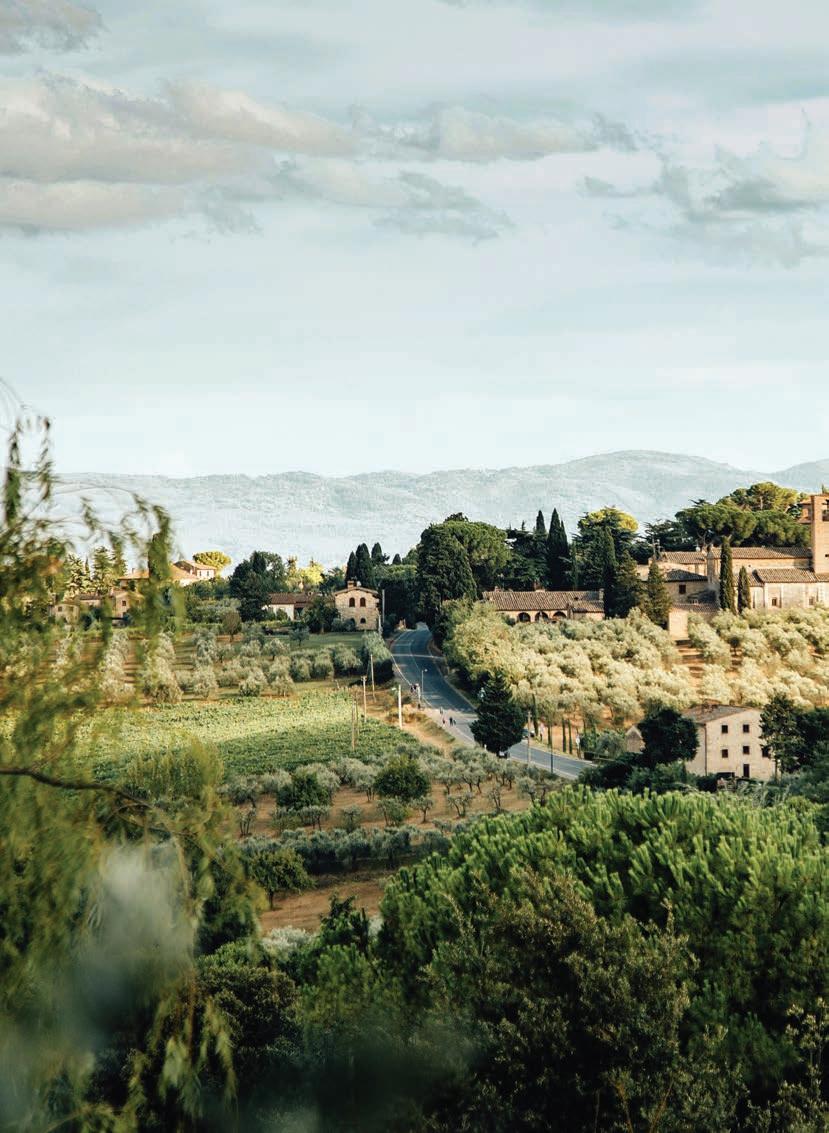
SUPER TUSCANS IV: SUPER TUSCAN STYLES OF WINE
This page: Tuscany is endowed with a Mediterranean climate partially influenced by the Apennine mountain range that delineates its eastern boundary in a series of rising foothills and ranges that run parallel to the spine of Italy and the Tyrrhenian coast. While no one characteristic defines the Super Tuscan family other than sheer originality in the choice of grape variety and even blend; a broad brush stroke generalization would highlight their propensity to the bold, powerful, often high in alcohol content, without lacking the necessary acidity for aging and balance, and having a spectrum of red to dark fruit flavours well imbued with strong secondary wood and spice textures that are fundamental to their complexity and richness, all the while kept in check by a clean minerality of gravel or clay and tertiary undergrowth for good measure. Views from San Gimignano, province of Siena. Photography Alexander Henke.
THIS IS WINE
“Fruit of the earth, work of human hands, blessed be God forever”
48
s such the Super Tuscan genre can be vaguely divided into two or three groups depending upon winemaking style and grape varieties used. Some go down the Tignanello route of tweaking the Chianti style blend by keeping to a predominance of indigenous grape varieties, such as Sangiovese of Brunello fame, and adding French variety grapes. Others take a leaf out of the Sassicaia cookbook, creating blends solely out of French variety grapes mainly Cabernet Sauvignon and Franc, and/or Merlot; Ornellaia and Solaia come to mind. A third group forgoes the blend route entirely to create single grape cuvées or monocepages, whether that be 100 percent Merlot as in the case of Masetto, or Sangiovese in the case of Flaccianello and Pergole Torte, writes Kris
Bonavita.

The key appreciation and qualitative question is the calibre of wine as a result of terroir (mainly climate and soil-related) and winemaking style (traditional versus modern). Incredible soils can give a strong mineral streak to complement the fruit and wood flavours. Choice of grape varieties can bring out the best expression of the climate and soils at hand, while blending of different varieties can add extra layers of complexity, consistency in different vintages, and greater aging potential.
Balance, concentration and equally finesse are important key elements in the making of a good wine and are affected by decisions made in the vineyard; regarding yield volumes and when to harvest for optimum phenolic ripeness; as well as skillful extraction during the fermentation processes in the winery or chai, and level of oak barrelling if at all.
Of course, regardless of the technological know-how in making a wine, the personality of a wine is very much dependent on the winemaker’s creativity which adds an extra dimension of je ne sais quoi to its enjoyment as a work of art in itself.
However, regardless of to what extent one understands the methodology behind every bottle, even if this adds to one’s appreciation, the proof of a good wine ultimately resides in its blind tasting and in one’s subjective tastes, for good reason.
49
SUPER TUSCANS
INSTAGRAM/FIRSTTHISISWINE
FOR CONSTANT REVIEWS ON WINES AVAILABLE IN MALTA AND GOZO FOLLOW US ON
Marchesi Antinori Tignanello 2020
exclusively represented by S. Rausi Trading Ltd
Tignanello together with Sassicaia can comfortably lay claim to be the first precursors of the modern day Super Tuscan. By Antinori’s own reckoning they were the first to age Sangiovese in barriques; to blend with non Chianti grapes (Cabs Sauv and Franc); and to forgo the use of white grapes in their blend. The estate is in the heart of the Chianti Classico region where two vineyards on limestone and schist rich Pliocene soils are specifically used for Tignanello (a San Giovese based blend) and Solaia (a Bordeaux based blend).
Tignanello 2020 opens up to wild cherry pie filling and crust pastry, cigar tobacco wrappings, mulberry jam, caramelised brioche and walnuts.
The attack holds good on the olfactory promise with droves of dark ripe and tart cherries wrapped in a textural delight of silky only needs time to get better genteel tannins all held together by a lengthy touch mineralised crushed stone seamlessly sweet and dry taut finish.
On day two a slew of berries, tomato pulp and garrigue herbs melted off by a savoury treacly molasses finish. Exacting peak flavours, elegant tannins, length and breadth with enough luminosity between layers and textures to actually enjoy the cadence and dance.
You can make powerful and intense wines; you can make balanced and delicate wines; but it requires lots of choice plots and plenty of nous to make a wine whose signature style is equally about balanced harmony as it is about
feisty complexity; explaining Tignanello’s established place in the Super Tuscan firmament.
This of course is still very young, super bright, utterly primary and delightful as many a good 2020; yet with woven streaks of tertiaries and secondaries on their wonderful journey of aging this beauty into a star in its own right. This can be drunk now, but be aware that Tignanello is famously and consistently more about style rather than vintage with each aficionado having their own choice preferences of which vintage best expresses or is beholden of glory and at which part of its aging trajectory you should really be drinking this. Just make sure you have more than one bottle to avoid disappointment.
 Above: The Tenuta Tignanello estate is in the heart of Chianti Classico, in the gently rolling hillsides between the Greve and Pesa river valleys. It extends over an area of 319 hectares, of which about 130 are dedicated to vines. Two of the estate’s prized vineyards are on the same hillside, Tignanello and Solaia, on soils that originated from marine marlstone from the Pliocene period rich in limestone and schist. The vines benefit from hot days and cool evenings through the growing season. Tenuta Tignanello, the vineyards. Photography Mauro Puccini, courtesy Marchesi Antinori Spa.
Above: The Tenuta Tignanello estate is in the heart of Chianti Classico, in the gently rolling hillsides between the Greve and Pesa river valleys. It extends over an area of 319 hectares, of which about 130 are dedicated to vines. Two of the estate’s prized vineyards are on the same hillside, Tignanello and Solaia, on soils that originated from marine marlstone from the Pliocene period rich in limestone and schist. The vines benefit from hot days and cool evenings through the growing season. Tenuta Tignanello, the vineyards. Photography Mauro Puccini, courtesy Marchesi Antinori Spa.
Supplier details: S. Rausi Trading has the full
of Marchesi
Wines. S Rausi Trading Ltd, Empire Stadium Str, Gzira. Tel 00356 2131 6210. Web srausi.com/shop
portfolio
Antinori
THIS IS WINE 50
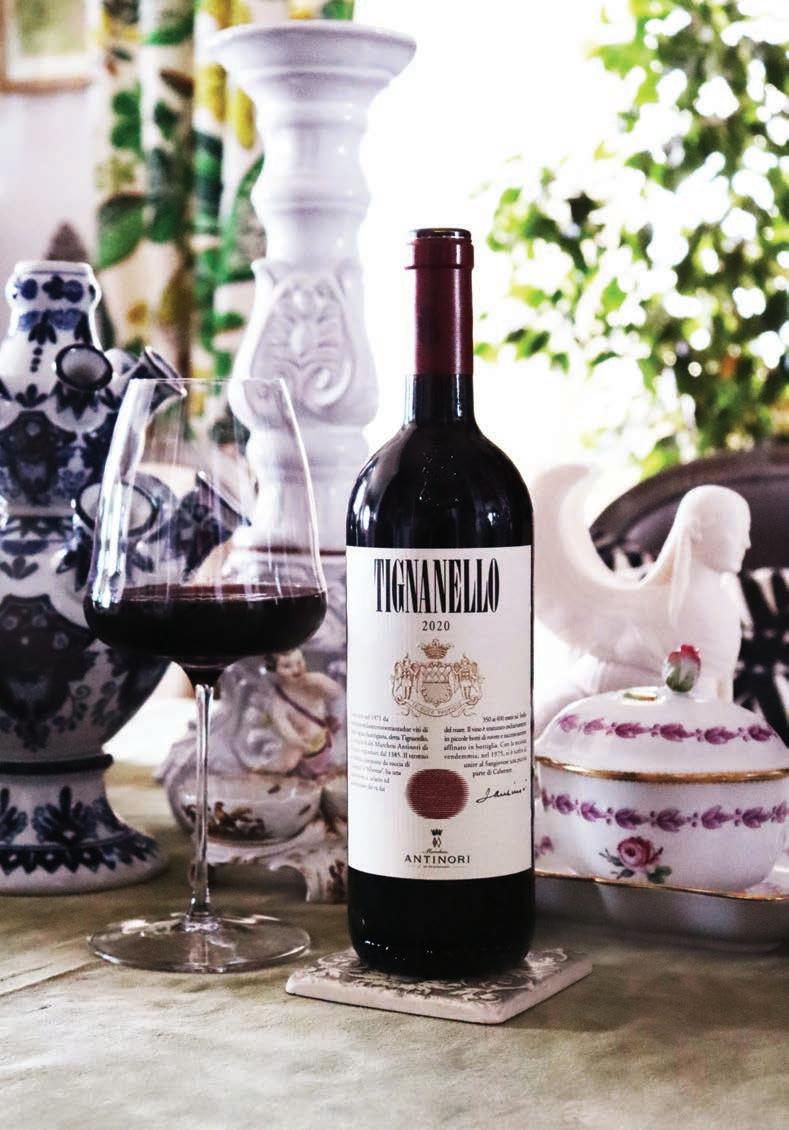
51 SUPER TUSCANS
first produced in 1994, and the inspiration for its creation was the desire to produce a 100% Syrah, one of Le Macchiole’s favorite grapes. Rare and original and produced in very small quantities, Scrio quickly became a benchmark in Bolgheri. Photography courtesy Le Macchiole
Le Macchiole Scrio 2016
Scrio is refreshingly and boldly 100 percent Syrah grown on old vines from the diverse holdings of Le Macchiole; featuring limestone marls, clays, fluvial sand and gravel. Produced in small quantities since 1994 (around 5000 bottles made), and influenced by the wine style of the Rhone valley, Scrio takes its inspiration from a Tuscan expression meaning 'pure, candid, whole'.
Le Macchiole is a small but important domaine in Bolgheri founded in the early 80s focusing on single grape cuvees to resounding success. Due
to their ideal location near the Tuscan coast with multiple vineyard plots and differing soils and exposures, they are at the forefront of expressing the region’s potential.
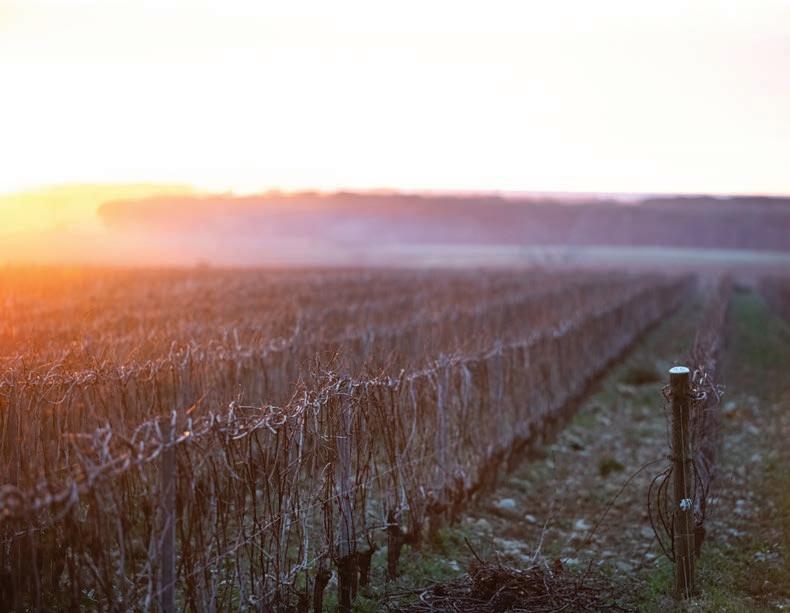
Scrio 2016 is ruby red with a dense bejewelled opacity, uncorking to a blackcurrant, berry, cedar, mint and vanilla bouquet. The attack is all dark cherries and berries with deep spice; white pepper, clove and cardamom; all ending in a dark chocolate and espresso slight anise finish. Already generous in the primaries and secondaries, yet an underlying current of unrealised textures beams huge aging potential.
On day two this opened up to a perfectly balanced yet exacting confection of dark forest fruit, baked spices, and old vine woods with weighty clays and floral gravels exuding a touching elegance. Munificent and lush with billowing layers of velvety textures, slowly revealing a brooding tertiary streak of leather and wet earth.
A wine with sculptural strength of good energy, wholesome structure, tense length and evolving complexity; this is textbook classical Syrah on steroids; given another decade this will really sing.
THIS IS WINE 52
Above: Founded in the early 1980s, Le Macchiole is a renowned Bolgheri winery, known for its quality Tuscan wines. Founders Eugenio Campolmi and Cinzia Merli played a pivotal role in the region's rise to fame by crafting characterful wines that are now iconic. Today, Cinzia, supported by her sons Elia and Mattia and a dedicated team, leads the winery. Scrio was
Supplier details: Farsonsdirect has a vast selection of Italian and French wines. In the Le Macchiole portfolio there is also Messorio, Paleo, and Paleo Bianco. Farsonsdirect, The Brewery, Mdina Road, B'Kara. Tel 00356 2381 4444. Web farsonsdirect.com
€139.84, exclusively represented by Farsonsdirect

53 SUPER TUSCANS
Vini Franchetti Campo di Tenaglia 2017
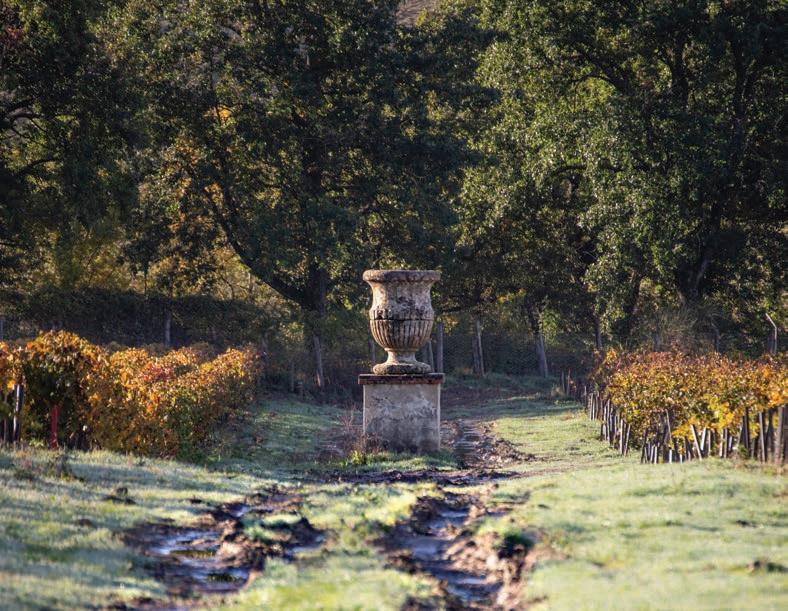
€195, exclusively represented by Vini e Capricci by Abraham’s
Tenuta di Trinoro is in the inner reaches of Tuscany in the Val D’Orcia region and was founded on virgin forest and farm land. The acclaimed vigneron Andrea Franchetti produces a much sought after Super Tuscan Bordeaux blend flagship wine by the same name. This rare cuvee (133 cases) is made entirely from Cabernet Franc grapes chosen from one specific west facing field of deep
crumbled limestone.
Campo di Tenaglia 2017 is all violets, blackberries, blackcurrants, leather and rich spice with a pencil shavings silhouette. The attack is dark forest berries and plums with a generously chewy mid palate for a Cabernet Franc cuvee, ending in a detailed lingering finish of coffee, dark chocolate, tobacco, smoke, herb and anise.
Deep and brooding in colour, texture and flavour this has a beautiful life ahead and though
quite primary yet complex; quickly develops a superb secondary structure true to the grape variety and concentrated but searing vintage. You get the ripe powerfully pithy small berried skin and stem maceration but also a tad dry, racy and tart astringent wood finish.
My take is either drink this upon opening now or cellar for a few good years to let some of these steep intense tannins soften and evolve into a more pronounced tertiary beauty.
Supplier details: Vini e Capricci has a vast selection of Italian and French wines. In the Vini Franchetti portfolio there is Palazzi Merlot 100%, Tenuta Di Trinorio, Campo Di Camagi, Campo Di Magnacosta, Rosso Terre Siciliane, Contrada Chiappemacine, Sancaba Pinot Noir 100%, Le Cupole, Passorosso Etna Rosso, and Passobianco Etna Bianco.
Vini e Capricci by Abraham’s, Gozitano Agricultural Village, Mgarr Road, Xewkija Gozo. Tel 00356 2156 3231. Web viniecapricci.com
THIS IS WINE 54
Above: In remote southeastern Tuscany, Tenuta di Trinoro specializes in rich, age-worthy red wines from Cabernet Franc, Merlot, Cabernet Sauvignon, and Petit Verdot. The estate, located in the Orcia Valley near Sarteano, where Tuscany meets Umbria and Lazio, was acquired by founder Andrea Franchetti in the 1980s. In the early 1990s, he began planting vines and drew a valuable lesson from his time in Bordeaux, emphasizing the importance of terroir. He recognized clay-limestone and gravel soils similar to those in Saint-Émilion in the rough woodland that would become Trinoro. Photograhy Enea Barbieri, courtesy Tenuta di Trinoro.

55 SUPER TUSCANS

NEGRONI WEEK 18TH TO 24TH SEPTEMBER 2023
NEGRONI FEVER
The Negroni is a classic cocktail that is said to have originated in Florence in 1919 at Caffè Casoni on Via de’ Tornabuoni. The drink was created for a regular customer named Count Camillo Negroni, who asked for an Americano (a mix of Campari, sweet vermouth, and club soda) to be made stronger by adding gin instead of soda. This simple modification led to the birth of the Negroni as we know it today. The Negroni’s popularity has led to variations like the Negroni Sbagliato, as well as global events like Negroni Week, when each September, bars and restaurants around the world come together to celebrate the iconic Negroni.

Photography this page Thomas Franke.

MIXOLOGY 57
With its vibrant red colour, bitter and herbal taste, and aromatic qualities, Campari is at the heart of the Negroni cocktail and a key ingredient in the classic Negroni recipe. A traditionally made Negroni is stirred, not shaken, and consists of equal parts of gin, Campari, and sweet vermouth; it is built over ice in an oldfashioned or rocks glass and garnished with a slice of orange. The bitterness of Campari provides a counterbalance to the sweetness of the vermouth and creates a well-rounded and complex flavour profile in the Negroni. Since it’s creation in the early 20th century, Negroni has since become a staple in the world of mixology, and variations of the cocktail have emerged over the years, allowing bartenders to add their own creative twists to the original recipe. Whether you enjoy it as it is or prefer a variation, the Negroni remains a timeless and iconic cocktail.
Classic Negroni Recipe
The iconic equal-parts mix of gin, Campari and sweet vermouth is simple to make –the secret: stirring the alcohols in a mixing glass to chill with ice, then strain over fresh ice to serve!

1oz Gin
1oz Campari
1oz Sweet Vermouth
Stir ingredients in a mixing glass with ice, strain into a chilled or ice-filled old-fashioned or rocks glass and garnish with a slice of orange.
Americano



The Americano is a simple and delightful cocktail that’s perfect for those who appreciate a lighter and less potent drink, known for its refreshing and slightly bitter profile.
1oz Campari

1oz Sweet Vermouth


Soda Water orange slice


Fill a highball glass with ice cubes. Pour in Campari and sweet vermouth. Stir gently to combine. Top with soda water. Give it another gentle stir. Garnish with an orange slice.

MIXOLOGY 58
Photography this page Sebastian Coman

Marketed and Distributed by Farsons Beverage Imports Co. Ltd. Trade Enquiry 2381 4400
Negroni Sbagliato


The Negroni Sbagliato is a delightful variation of the classic Negroni cocktail, and the drink’s name suggests that it was created by mistake when a bartender accidentally used sparkling wine instead of gin. The Negroni Sbagliato offers a lighter and bubbly twist on the classic Negroni, making it a refreshing choice, especially during warm weather or as an aperitif.
Fill a mixing glass with ice. Pour in Campari and sweet vermouth. Stir well to chill ingredients. Strain into a glass filled with ice. Top off with sparkling wine. Give it a gentle stir to combine ingredients. Garnish with an orange slice.



MIXOLOGY 60
1oz Campari
1oz Sweet Vermouth
1oz Sparkling Wine or Prosecco or similar orange slice for garnish
Boulevardier

The Boulevardier is a classic cocktail from the 1920s that shares similarities with the Negroni but replaces gin with bourbon or rye whiskey. It offers a rich and slightly sweeter twist on the bitter and herbal flavours. The Boulevardier has a smooth balance of sweet, bitter, and spicy notes from the whiskey and is a great option for those who enjoy the flavours of a Negroni but prefer the warmth and depth of whiskey as the base spirit.

1.5oz Bourbon or Rye Whiskey











1oz Sweet Vermouth
1oz Campari orange twist
Fill a mixing glass with ice. Pour in bourbon or rye whiskey, sweet vermouth, and Campari. Stir well to chill and combine flavours. Strain into a glass with a large ice cube or over fresh ice. Express oils from orange twist over drink by giving it a gentle twist to release the aromas. Drop into the glass.
Aperol Negroni
The Aperol Negroni, also known as the “Aperol Spritz Negroni” or “Aperol Negroni Spritz,” is a variation of the classic Negroni that incorporates Aperol, which is lighter and slightly less bitter. The Aperol Negroni offers a lighter and fruitier twist on the traditional Negroni by using Aperol’s citrus and herbal flavours. It’s a great option for those who enjoy the Negroni’s concept but prefer a milder bitterness and a touch of refreshing sweetness.
1oz Aperol
1oz Gin
1oz Sweet Vermouth orange slice
Fill a mixing glass with ice. Pour in Aperol, gin, and sweet vermouth. Stir to combine and chill ingredients. Strain into a glass filled with ice. Garnish with an orange slice or twist.
Cynar Negroni
The Cynar Negroni is a variation of the classic Negroni that replaces Campari with Cynar, an Italian amaro made from artichoke and various botanicals. This substitution gives the cocktail a unique and earthy flavour. The Cynar Negroni offers a more herbaceous and vegetal character compared to the traditional Negroni, making it a great choice for those who appreciate complex and slightly bitter flavours. The artichoke-based Cynar adds a unique and intriguing element to the cocktail.
1oz Gin

1oz Sweet Vermouth
1oz Cynar orange twist
Fill a mixing glass with ice. Pour in gin, sweet vermouth, and Cynar. Stir well to combine and chill ingredients. Strain mixture into a glass filled with ice. Garnish with an orange twist.
MIXOLOGY
Photography this page Wine Dharma. 61

LET’S GET PHYSICAL
We've all heard it from at least one person in our lives: regular exercise has long-term benefits – both physically and mentally. But did you know that regular exercise has also been associated with a reduced risk of dementia? Here's a quick read to get you motivated.
 Photography Alexey Lin.
Photography Alexey Lin.
Physically, regular exercise can improve your cardiovascular health by strengthening the heart and improving circulation, reducing the risk of heart disease, high blood pressure, and stroke. In turn exercise can help control body weight by burning calories and building – and also maintaining – lean muscle mass. Maintaining a healthy weight helps to lower the risk of obesity-related conditions such as type 2 diabetes. Exercise can help regulate blood sugar levels and improve insulin sensitivity, which is beneficial for individuals with or at risk of type 2 diabetes
Importantly weight-bearing exercises like resistance training and weightlifting help increase muscle mass and bone density, reducing the risk of osteoporosis and fractures. As we age both men and women naturally lose muscle mass –muscle mass is directly linked to bone health, and by engaging in resistance training and weightlifting exercises this can be counteracted. Additionally activities like yoga and stretching helps improve flexibility and balance, which helps reduce the risk of falls and injuries – especially in older adults. Interestingly regular physical activity can also help alleviate chronic pain such as lower back pain and arthritis by strengthening supporting muscles and promoting joint health.
Mentally, regular exercise can help with stress reduction, better sleep, mood regulation, and even self-esteem. Exercise triggers the release of endorphins – your bodies natural mood lifters which help reduce stress and promote relaxation. Exercise has also been linked to improved cognitive function, memory, and concentration, and can also boost creativity.
Several studies suggest that regular physical activity may help maintain brain health and protect against age-related cognitive decline. A key benefit of exercise could be that it helps the brain make new neurons. Increased blood flow to the brain may help to enhance cognitive function and support new brain cell growth, and exercise may help reduce the risk of vascular dementia by improving cardiovascular health and reducing the risk factors for this form of dementia.
Remember to consult with a healthcare professional before starting a new exercise regimen, especially if you have any existing health conditions.
HEALTH & FITNESS Photography this page Renith R.
63
WORLD ALZHEIMER’S MONTH
World Alzheimer’s Month, established in 2012 and aligning with World Alzheimer’s Awareness Day on September 21st, aims to raise awareness about available support for those impacted by dementia. Dementia is an umbrella term describing various symptoms that impact one’s ability to perform daily tasks, whereas Alzheimer’s is a specific disease and the most common cause of dementia. Understanding these distinctions is essential for individuals with Alzheimer’s or other dementias, along with their families and caregivers. Dementia encompasses various symptoms linked to memory and thinking decline, with numerous underlying causes. Alzheimer’s accounts for 60-80% of dementia cases and isn’t a typical part of aging; it results from brain cell damage affecting communication, impacting cognition and behavior. Alzheimer’s, a degenerative brain disease, arises from complex brain changes after cell damage, leading to progressive dementia symptoms. Early signs often involve memory problems, as it initially affects the brain’s learning center. With advancement, symptoms worsen, including disorientation, confusion, and behavioral changes. While age is a significant risk factor, Alzheimer’s isn’t a natural aspect of aging. Younger-onset Alzheimer’s can also occur.

COMMUNICATING WITH PEOPLE LIVING WITH DEMENTIA THE DO YOU REMEMBER ME DILEMMA

Dementia affects everyone differently so it’s important to communicate in a way that is right for the person. Although it may be hard to accept, it is not important that the person recognsises you, but that you spend quality time together. It’s crucial to tailor your approach to their needs. Here are 5 things to avoid saying to somebody with dementia: Instead of saying, “REMEMBER WHEN...?” which can often be a reminder of memories lost, gently share your own memories using “I remember when...” to help them engage if they wish. Avoid saying, “I’VE JUST TOLD YOU THAT,” as reminding a person that you’ve answered their question won’t aid their memory and may remind them of their condition which may be distressing for you both. Respond patiently and consider taking breaks if needed –remember that the person cannot help repeating themselves. Don’t ask open-ended questions about the past, like “WHAT DID YOU DO THIS YESTERDAY?” Focus on the present instead as it could be stressful for a person with dementia to remeber the past. Instead of asking, “DO YOU RECOGNIZE ME?” opt for a friendly greeting or stating your name and relationship to them, as recognition can be challenging and upsetting. Lastly try to AVOID LONG COMPLEX SENTENCES, like for example Let’s have lunch, then go shopping, and then maybe we can go for a coffee – keep instructions simple and one step at a time, as complex sentences can be difficult for those with dementia to process due to slowed cognitive abilities.

HEALTH & WELLBEING Photography this page Mike Meyers.
64
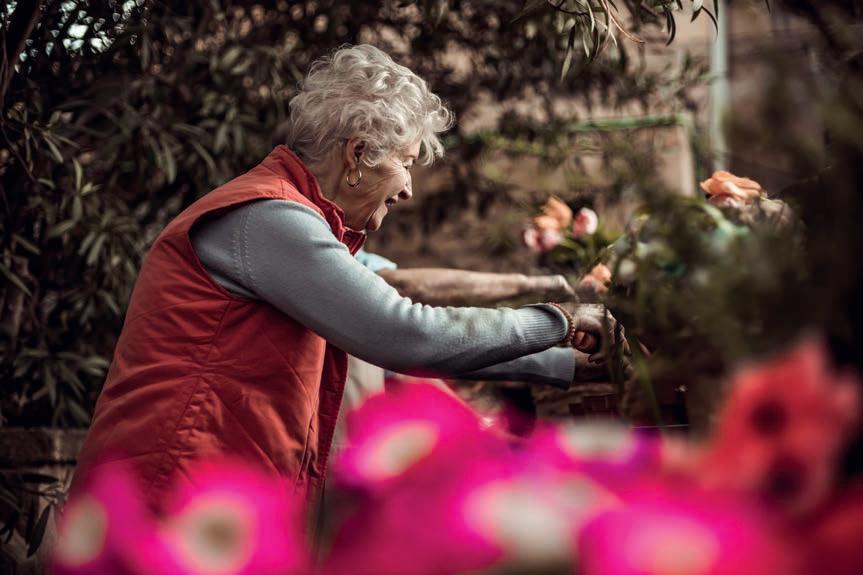

Dementia Awareness Month
Throughout this month dedicated to dementia, individuals, communities, and organisations unite in a collective effort to disseminate knowledge, promote empathy, and advocate for enhanced support systems for those affected by dementia and their caregivers. Dementia, a syndrome characterised by cognitive decline beyond what might be expected from normal ageing, presents a range of challenges that extend well beyond the individual directly impacted. By equipping individuals with a deeper comprehension of the condition, we can diminish stigma and misconceptions, fostering environments that engender respect, patience, and support for those individuals with dementia.
Furthermore, Dementia Awareness Month stands as an opportunity to reinforce the significance of early detection, intervention, and comprehensive care planning. Seminars, workshops, informational campaigns, and online resources play a crucial role in disseminating accurate information, empowering individuals to recognise potential signs of dementia, and encouraging them to seek professional guidance when necessary. Let this month serve as a reminder that every action we take in raising awareness and promoting support contributes to a brighter and more compassionate future for all, writes the team at Saint Vincent de Paul.
UNDERSTANDING ALZHEIMER’S DAY: ENLIGHTENING PERSPECTIVES ON SEPTEMBER 21ST
On September 21st, we find ourselves presented with a unique opportunity to deepen our understanding of a condition that profoundly impacts the lives of millions worldwide.
Alzheimer’s is a progressive neurological disorder characterised by cognitive decline and memory impairment. It affects not only the individual diagnosed but also their families, caregivers, and communities.
Alzheimer’s disease is one of the leading causes of dementia, affecting individuals across diverse age groups. Its prevalence is expected to rise as the global population ages, thus emphasising the urgency of awareness and research efforts.
Recognising the signs and symptoms of Alzheimer’s in its early stages empowers individuals to seek timely medical intervention. Early diagnosis can help manage symptoms and plan for the future effectively.
Alzheimer’s Day reminds us of the significance of raising public awareness about the challenges faced by those living with Alzheimer’s. It is a call to action, prompting us to educate ourselves. Caregivers play an integral role in the lives of individuals with Alzheimer’s. The observance of this day extends support and recognition to these individuals, who selflessly dedicate themselves to the care and well-being of their loved ones.
As we prepare to commemorate Alzheimer’s Day on September 21st, let us join forces in raising awareness, fostering empathy, and advocating for improved care and support systems. By dispelling stigma and misinformation, we contribute to a more compassionate society that respects and dignifies the journeys of individuals and families navigating the challenges posed by Alzheimer’s disease.
ENHANCING DEMENTIA CARE AT ST. VINCENT DE PAUL

At St, Vincent de Paul (SVP) our commitment is to provide excellent care and to give the best quality of life to individuals with dementia (IWD). It extends beyond medical treatment to encompass a holistic approach that emphasises effective communication, informed decision-making, and continuous education. As part of this commitment, our team serves as a
vital clinical point of contact for IWD, their families, and the professionals involved in their care.
KEY RESPONSIBILITIES AND CONTRIBUTIONS
St Vincent de Paul serves as a consistent and invaluable source of guidance and support for IWD, their relatives, and professionals. Our role involves facilitating open and empathetic communication, ensuring that all parties remain informed, empowered, and reassured throughout the care journey.
By maintaining robust communication channels with IWD, families, carers, and professionals,we foster an environment of collaboration and shared understanding. This ensures that relevant information is disseminated promptly and accurately.
Recognising the complexities associated with dementia, we are dedicated to offering tailored support, education, advice, and information to all stakeholders. This includes providing guidance on care strategies, addressing concerns, and facilitating informed decision-making.
Our team actively collaborates with other professionals to shape policies, procedures, and clinical guidelines that reflect best practices in dementia care. We engage in policy development and influence by contributing our clinical insights and experiences to ensure a comprehensive and patient-centred approach.
Our presence at Multidisciplinary Team Meetings, including those involving relatives, highlights our commitment to collaborative care. By actively participating and offering valuable insights, we contribute to well-rounded discussions and decision-making processes.
We believe in equipping professionals, carers, and relatives with the knowledge and skills needed to provide exceptional dementia care. Our team designs and delivers targeted education and training sessions that enhance their understanding and capabilities. To keep abreast with dementia knowledge we offer a comprehensive Dementia Accreditation Course, specifically tailored for nursing staff, including carers. This course is designed to provide a comprehensive and in-depth understanding of dementia care. We are also pleased to offer a Dementia 10-week program course designed for persons in the community, which includes understanding and knowledge of dementiarelated changes, skills and coping strategies thus fostering a holistic approach to dementia care and support.
DEMENTIA-FOCUSED ACTIVITIES AND OUTINGS AT SVP
At SVP a range of activities and outings have been carefully designed for the well-being and enrichment of IWD.
We recognise the importance of providing meaningful and engaging experiences for individuals living with dementia. Our activities and outings are purposefully crafted to promote cognitive stimulation, social interaction, and emotional well-being, all of which contribute to enhancing the overall quality of life for our participants. We are proud to offer a variety of activities that cater to the unique needs and preferences of IWD. Theseactivitiesencompass creative arts, music therapy, sensory experiences, reminiscence sessions, gentle exercise, and more. Each activity is thoughtfully designed to accommodate varying cognitive abilities, fostering a sense of accomplishment and enjoyment. In addition to our on-site activities, we recognise the importance of venturing beyond our walls to explore the world around us. Our scheduled outings provide participants with the opportunity to engage with the community, experience various environments, and enjoy nature’s beauty.
These outings are planned with utmost consideration for safety, accessibility, and the comfort of our IWD. We have witnessed firsthand the positive impact these activities and outings have on the participants’ mood, behaviour, and overall well-being. Moreover, our initiatives extend to the families and caregivers of these individuals, offering respite, support, and the knowledge that their loved ones are engaging in meaningful and enjoyable experiences. Our commitment to enhancing the lives of IWD is fortified by collaboration among our dedicated staff, caregivers, and healthcare professionals. Through ongoing communication and feedback, we ensure that our activities and outings are tailored to address the evolving needs and preferences of our IWD.
Our dedication to providing purposeful activities and enriching outings for IWD underlines our holistic approach to care. We believe that every individual deserves a life filled with dignity, engagement, and moments of joy. It is with great pride that we continue to offer these opportunities that contribute to the well-being and happiness of those in our care.
67 HEALTH & WELLBEING



RAISING AWARENESS ABOUT ALZHEIMER’S DEMENTIA, OTHER TYPES OF DEMENTIA, AND RISK REDUCTION
WORLD ALZHEIMER’S DAY 2023
September is the month internationally dedicated to Dementia, with the 21st of September named as World Alzheimer’s Day. Throughout this month, numerous organisations and entities around the world campaign to educate and raise awareness about Dementia. The aim of such activities is to encourage and support those living daily with this condition and promote the importance of consistent research to further our understanding and management of this condition. This year the focus is on risk reduction that is, identifying risk factors for dementia, making the public aware of these, and how they may be tackled to decrease the risk of dementia in the future, writes
Dr Nicole Marie Zerafa, General Practitioner, Dementia Care Directorate.
The number of dementia cases in Malta has been steadily rising over the past few years. It is estimated that there are currently around 7,500 cases in Malta, with this number set to continue to increase over the next few years.
Dementia is a term comprising several symptoms which come about from disorders of the brain function which affect the individual’s ability to live their normal daily life. The process is a physical one, but the symptoms may be physical or cognitive and often demonstrate the greatest impact on memory, thinking, behaviour and emotions. The most common type of Dementia is Alzheimer’s Dementia, amounting to about 70% of diagnosed cases, but other types exist, such as Vascular Dementia, which is the second most common type, Lewy Body Dementia, and Frontotemporal Dementia among others.
Alzheimer’s Dementia occurs due to physical changes in the brain that are commonly seen with ageing. As time goes by, the brain’s cellular structure changes (cells deform or die), causing overall changes in the size and shape of the brain. These changes, as well as the location in the brain where they occur, affect a person’s overall function, resulting in different signs and symptoms which eventually become noticeable. With Alzheimer’s Dementia, which tends to affect the frontal part of the brain, the most common symptoms are memory loss (especially recent), speech difficulties, poor concentration, disorientation, difficulty in judgement, and low mood. These tend to begin slowly and worsen over time because the process of brain change occurs slowly.
In contrast, Vascular Dementia is related to injury in the brain from damaged or blocked blood vessels which can lead to strokes, that therefore result in damage or death of brain cells. The symptoms in this case are related to where the damage occurs, but the most common symptoms of this type of dementia are confusion, disorientation, speech difficulties, and difficulties in walking and balance. The other types of dementia occur through different processes and produce other symptoms.
This year the slogan chosen for World Alzheimer's Day is “never too early, never too late”. The diagnosis of dementia should be made at any stage of the process. Interventions to manage this condition should be initiated whatever the stage of the condition. The same may be said for risk reduction; any risk factors identified in an individual’s case should be managed to enhance brain function as far as possible. Through research, several risk factors have been identified as increasing the risk for developing or worsening dementia, including depression, diabetes, excessive alcohol consumption, head injuries, hypertension, obesity, smoking, physical inactivity, and social isolation.
Weight control, regular exercise, a healthy diet, diabetes control, blood pressure control and smoking cessation are all included in the management of dementia. Discussing with a General Practitioner, either a personal family doctor or those located in the Primary Care Centres around Malta and Gozo, about controlling any of these risk factors plays an important role in risk reduction of possible future dementia. It also aids in diagnosing and managing dementia, apart from possible referral to other specialised services.
The local Dementia helpline 1771 is a 24/7 telephone helpline that provides advice to dementia patients and provides information about the multiple services offered by the local Dementia Care Directorate within the Active Ageing and Community Care. Advice can also be given on how to proceed if an individual is suspected of having dementia signs and symptoms.
THE DEMENTIA INTERVENTION TEAM WILL BE HOSTING AN INFORMATION STAND NEXT TO THE PARLIAMENT BUILDING IN VALLETTA BETWEEN THE 20TH AND 23RD SEPTEMBER 2023. SEVERAL PROFESSIONALS WILL BE AVAILABLE TO ANSWER AND EXPLAIN ANY QUERIES.
All senior citizens over 60 years of age, or known cases of dementia, are encouraged to make use of the services available that are provided by the Dementia Care Directorate within the Active Ageing and Community Care. Further details are available online on aacc.gov.mt, on telephone numbers 153/22788900, email aacc-services@gov.mt / dit.aacc@gov.mt / dcd.aacc@gov.mt, or by visiting Ċentru Servizz Anzjan at 3, Old Mint Street, Valletta, Malta, or Elderly Service Centre at 39, Republic Street, Victoria, Gozo.
HEALTH & WELLBEING
71
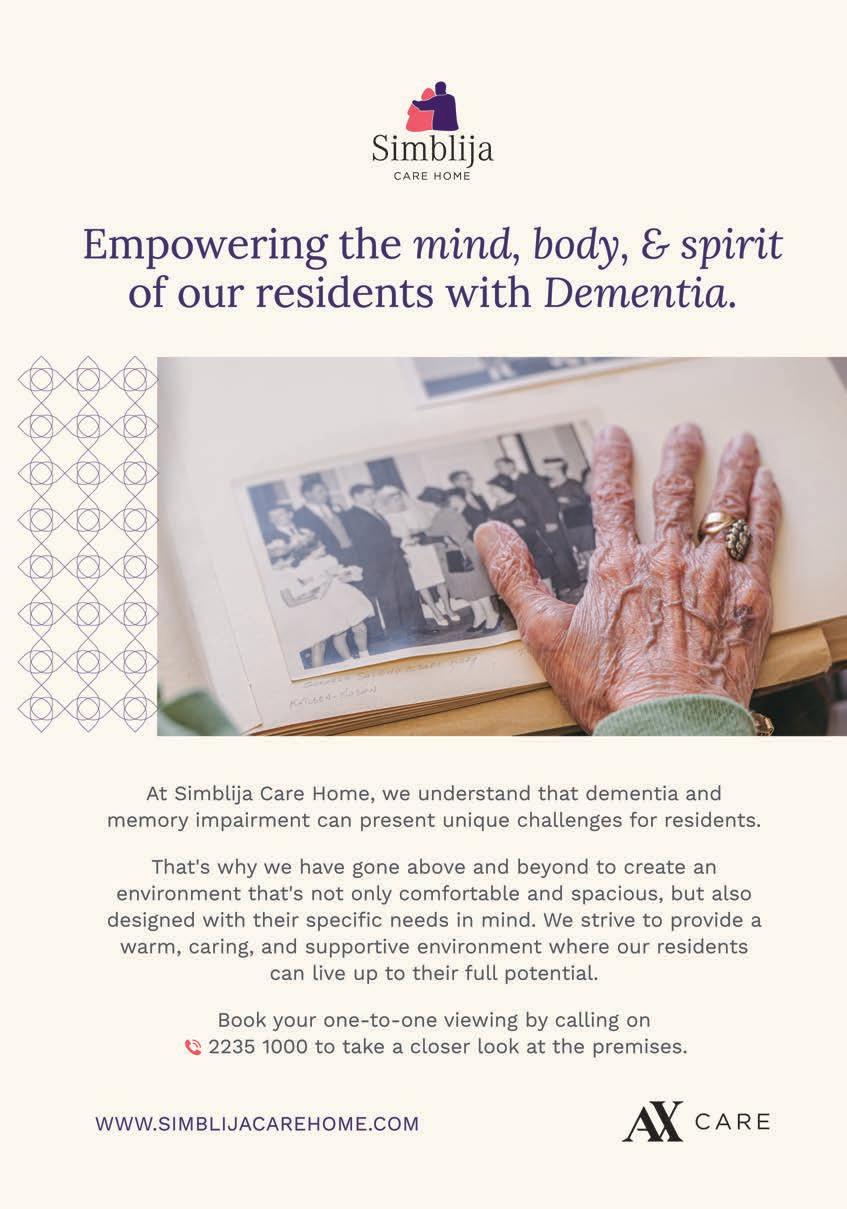
How to Spot Signs of Dementia in a Loved One
It is very difficult to watch a loved one go through changes as they age, and it can be challenging to know when to seek help. As people get older, the risk of developing dementia increases. At Simblija Care Home, we understand the significance of this journey and are here to support you.
Early intervention can help slow down the progression of the disease, making it essential to be aware of these signs. It’s important to remember that the following patterns can prove distressing and alarming for your loved one, so it’s crucial to approach them with compassion and understanding.
PERSISTENT CHANGE IN BEHAVIOUR
If you notice a persistent change in your loved one’s behaviour, it could be a sign of dementia. They may seem more forgetful, confused, or struggle to complete familiar tasks.
MEMORY LOSS
Memory loss is one of the most common signs of dementia. Your loved one may forget recent events, names, and faces. They may also struggle to find the right words to express themselves.
DIFFICULTY IN LEARNING NEW THINGS
Dementia can make it challenging for your loved one to learn new routines, skills, or adapt to changes in their environment.
FINANCIAL MANAGEMENT
Dementia can affect a person’s ability to manage their finances. Your loved one may forget to pay bills, make inappropriate purchases, or struggle to manage their bank account.
LOSING TRACK OF TIME
Your loved one may forget what day it is or what time it is. They may also forget appointments or important events. It can be helpful to create a daily schedule for your loved one to help them stay on track.
LOSS OF INTEREST IN ACTIVITIES
Dementia can cause a person to lose interest in activities they used to enjoy. Your loved one may stop participating in hobbies or social events they used to enjoy. They may also withdraw from social interactions and become more isolated.
REPEATING THEMSELVES
Your loved one may tell the same stories or ask the same questions over and over again.
If you think you have spotted signs of dementia in a loved one, there are several proactive steps you can take. Firstly, you can document and share these patterns with a doctor. Keeping a record and tracking signs can help to provide a clearer picture of the progression of the disease.
It is important to find professional help after noticing early symptoms of dementia. At Simblija Care Home, we specialise in dementia care and can guide you through this challenging journey. Begin by selecting the right doctor who specialises in dementia care and communicate your observations in detail. Preparing for a diagnosis can involve reviewing their medical history, physical or mental exams, lab tests, and brain imaging. It’s important to continue to observe and track the symptoms to help you and the medical professionals determine the best care and treatment for your loved one.
As difficult as it may be to accept, planning for the future is essential. Seeking professional care and exploring long-term care residential options may be challenging at first. Rest assured our resident-centered team approach will guide and assist you through this journey with the highest level of professionalism, competence, and compassion.
Your loved one may feel scared or vulnerable, so it is essential that they recognise that you have their best interests at heart.
Learn more about the compassionate and comprehensive care we offer to individuals living with dementia at Simblija Care Home. Our team is here to support you and your loved one through this challenging time, and we are committed to providing the highest quality care possible.
What's more, we are organising a special event to give you a chance to build friendships and connect with our team over tea and tasty delights on Saturday 21st October from 9:30 am till 12:30 pm at Triq il-Forga, Naxxar. Give us a call on 2235 1000 to book your spot today and learn more about life at Simblija.
73 PROMOTION


PERSONAL ENER GY FINANCE LOW INTEREST RATES All loans are subject to normal bank lending criteria and final approval from the Bank. The term of the loan must not go beyond retirement age. Issued by Bank of Valletta p.l.c. 58, Triq San Żakkarija, Il-Belt Valletta VLT 1130. Bank of Valletta p.l.c. is regulated by the MFSA and licensed to carry out the business of banking in terms of the Banking Act (Cap. 371 of the Laws of Malta). SWITCH NOW, GO ECOO bov.com/personalenergy | @bovofficial EERE Malta is co-financed by the Republic of Malta, the European Union under the European Regional Development Fund.
GOING CARBON NEUTRAL & SUSTAINABILITY, REDUCING EMISSIONS, URBAN GARDENS AND ENVIRONMENTAL CARE


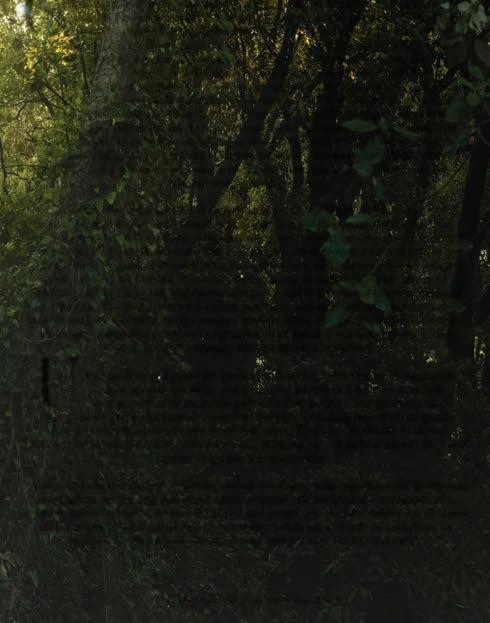



GOING CARBON NEUTRAL UNWRAPPED
Climate change is one of our most pressing global challenges, a topic scientists have emphasised for decades. It signifies the ongoing transformation of Earth's climate due to human actions, chiefly the release of greenhouse gases like carbon dioxide, methane, and nitrous oxide. These gases, which trap heat in the atmosphere, contribute to global warming. So, where do these gases come from?
Carbon dioxide, mainly from human activities such as burning fossil fuels (such as coal, oil and natural gas), deforestation, and industrial processes, is the most abundant greenhouse gas. Deforestation and land-use changes also release carbon dioxide as trees store carbon, and their removal releases it into the atmosphere. Methane emissions, resulting from natural and human sources, come from fossil fuel production, livestock digestion and manure management in agriculture, and the decay of organic waste in landfills. Methane is a potent greenhouse gas, with a much higher heattrapping potential per molecule than carbon dioxide. While it doesn't persist in the atmosphere as long as carbon dioxide, it can have a significant impact on global warming, especially in the short term. Nitrous oxide emissions, stemming from both natural and human activities, include agriculture (especially with the use of synthetic fertilizers) and industrial processes. Nitrous oxide, like methane, has a higher heattrapping potential per molecule compared to carbon dioxide and contributes to climate change and ozone depletion.
To address the consequences of climate change, the notion of "achieving carbon neutrality" has become increasingly significant. Being carbon neutral entails finding equilibrium between the volume of greenhouse gases released into the atmosphere and those removed from it. Sustainability is of paramount importance for safeguarding Earth's natural resources, biodiversity, and ecosystems, all while maintaining a high quality of life for everyone. It assumes a pivotal role in tackling climate change by curtailing carbon emissions and encouraging responsible patterns of consumption and production. The journey toward carbon neutrality and sustainability encompasses transitioning to renewable energy sources, implementing energy-efficient technologies, endorsing sustainable practices in agriculture and forestry, minimizing waste, and embracing eco-friendly transportation alternatives.
Urban gardens and parks are green spaces within cities that are designed for recreational, aesthetic, and ecological purposes. These areas include community gardens, public parks, rooftop gardens, and green corridors. Urban gardens and parks provide numerous benefits, including improved air quality, enhanced urban biodiversity and stress reduction. They also contribute to climate resilience by acting as natural cooling systems, reducing the urban heat island effect and promoting carbon sequestration.
Addressing climate change, achieving carbon neutrality, reducing emissions, promoting green urban spaces, and practicing environmental care are critical components of a comprehensive strategy to protect the planet and ensure a sustainable future for all. These efforts require global commitment, innovative solutions, and individual actions to mitigate the impacts of climate change and preserve the environment.
Photography this page Sonny Baccam. 75 ENVIRONMENT


“That old September feeling, left over from school days, of summer passing, vacation nearly done, obligations gathering, books and football in the air... Another fall, another turned page: there was something of jubilee in that annual autumnal beginning, as if last year's mistakes had been wiped clean by summer.”

Wallace Stegner, Angle of Repose

BACK TO SCHOOL 78
PHOTOGRAPHY THIS PAGE: VIEW FROM VILLA RUFOLO IN RAVELLO ON THE AMALFI COAST, LYNN VAN DEN BROECK.
7 TIPS TO HELP CHILDREN COPE
Going back to school after the summer holidays can be a big deal. For some children, it means moving into a new classroom with a new teacher. Others will be going to a new school altogether. Change can be exciting, but it’s often scary, too. Your child might be feeling a version of the “Sunday scaries” we sometimes experience when the weekend’s over – a miserable anticipation of the boring old routine starting back again. Or they might be experiencing more significant emotional distress, perhaps wanting to avoid school altogether. If your child is feeling fearful and anxious about the return to school, you may be unsure how to help them. This can be an upsetting and challenging situation for you as a parent or carer, too. Here are some steps to take to help your child with their return to the classroom write Lecturer Trudy Meehan and Senior Lecturer Jolanta Burke at the Centre for Positive Psychology and Health, RCSI University of Medicine and Health Sciences, Ireland.
1 LET YOUR CHILD KNOW YOU HEAR THEM

It might be tempting to dismiss your child’s fears with a quick reassurance that everything will be OK. But it is more helpful to let them know that you understand and believe them, and that you will work with them as they get back into the school routine and do whatever you can to support them. This can help your child move on from negative emotions and towards solving the problem with you.
2
FIND OUT WHAT’S WORRYING THEM
There are various reasons why your child might not want to go back to school. They might be trying to avoid something negative: bullying, a difficult environment created by teachers, struggles interacting with their classmates or academic pressure. They might have neurodevelopmental issues, such as autism, ADHD or dyslexia, that make school difficult, or a mental health issue such as anxiety.
Or they may be worried about leaving the home they’ve got used to spending all their time in over the summer holidays, and having to learn instead in a bright, noisy environment that may be overwhelming. They might be feeling some separation anxiety, wanting to stay close to you. Finding out what in particular is worrying them will help you work out a solution – perhaps with the assistance of a teacher or other professional.
3 LET THEM KNOW IT’S OK TO FEEL SCARED
If your family is experiencing back-to-school anxiety, both you and your child may be feeling a little bit inadequate and ashamed of these feelings. But this fear is not a sign of weakness. It’s an understandable challenge, with a genuine cause, that you and your child have the capacity to understand and overcome. By going through this challenge and facing it with the right support, you and your child can end up feeling more capable and more resilient.
4 TAKE THINGS STEP BY STEP
Going straight back into school – seeing classmates and teachers again all at once – might be a lot to handle. You could set up a playdate or social meet for your child with a few school friends in the days before school starts, so they can catch up before the first overwhelming day. Breaking a task down into bite-size chunks and focusing on small successes that you can link together over time can make a big hurdle –like the return to school – more manageable.
5 FOCUS ON SLEEP

Sleep routines probably went out the window over the holidays, and everyone at home will struggle to deal with earlier bedtimes and morning alarms. Teenagers, in particular, will find it difficult – a shift in sleep patterns from puberty can push the time they feel ready to sleep later by as much as two hours. Unfortunately, though, this doesn’t reduce the amount of sleep that they need (about nine hours a night).
But sleep is important for mood and academic performance. Try to be kind and compassionate with yourself and everyone else in the house, and see if you can all get to bed at least 15 minutes early in the week before school starts. If you can’t manage this or if it’s already too late, there are other ways to improve sleep. Exercise during the day, cutting caffeine intake, reducing evening screen time, and even missing some extracurricular activities at the start of the school year might be helpful.
6 PAY ATTENTION TO YOUR OWN MOOD
Try to reduce your own negative talk about the return to school. If you’re unhappy about going back to the school routine, then it’s likely your children will follow your lead. Try to avoid negative conversations, in real life or online, about going back to school. If you can’t manage to be positive, and there’s another adult in the house or family, you can ask them to support you by being positive and acting as a counterbalance to your anxiety or negative thoughts.
7
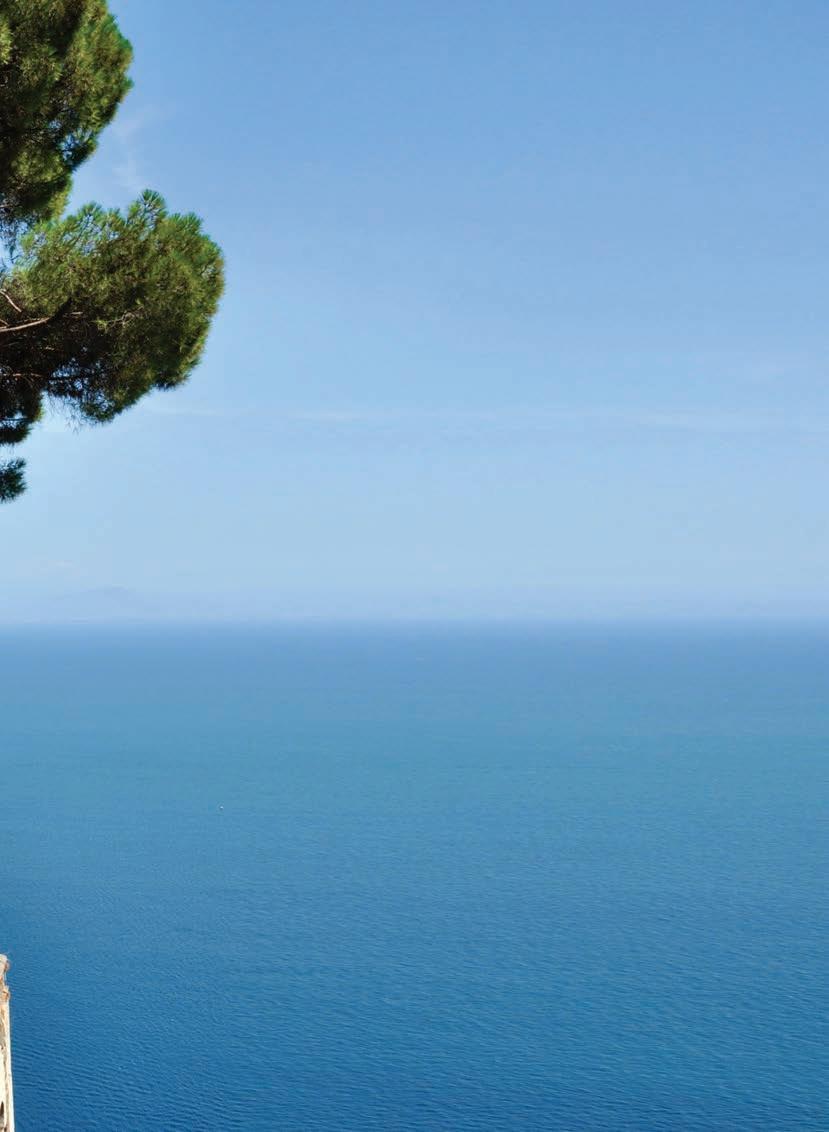
ENCOURAGE OPTIMISM
Practice thinking optimistically with your child. Before going to bed each night, you could both write down three things you are looking forward to the following day –seeing friends, an after-school club, a favourite meal. This can help you both balance out the negative emotions you might be feeling about the day ahead.
This article first appeared on The Conversation.

79 BACK TO SCHOOL BACK-TO-SCHOOL ANXIETY
Research has shown that the lack of financial literacy can lead to a range of problems, from struggling with debt to making poor financial choices. By starting financial education early, we can help our children build a solid foundation of financial well-being.

BACK TO SCHOOL 80
Teaching Children the Lifelong Skill of Money Management
Teaching children money management is an investment in their future well-being. Petra Ellul-Mercer, Financial Capability Project Developer at ĠEMMA's explains the importance of instilling this crucial life skill from a young age and how innovative tools like AI-powered budget planners and gamification can help make it engaging and educational. Photography Fabian Blank.
THE STRESS-REDUCING POWER OF FINANCIAL LITERACY
Financial literacy is not just about understanding numbers: it’s about gaining control over your financial life; it is a skill set that equips us with the knowledge and abilities to make informed decisions about our finances. According to the Organisation for Economic Co-operation and Development (OECD), financial literacy is not only a critical life skill, but also a global concern. According to a 2019 OECD report, only one in three adults in OECD countries possesses the necessary financial literacy skills to make sound financial decisions.
Research has shown that the lack of financial literacy can lead to a range of problems, from struggling with debt to making poor financial choices. By starting financial education early, we can help our children build a solid foundation of financial well-being. When children learn how to manage money responsibly, they are better equipped to navigate the complexities of adulthood, from managing debt and saving for the future to dealing with unexpected financial setbacks. This early education can significantly reduce stress and anxiety when it comes to money matters.
STARTING EARLY: A FOUNDATION FOR FINANCIAL SUCCESS
Many important decisions happen early in life, the sooner we start teaching children about money, the better. Just as it is not possible to thrive in an industrialised society without the ability to read and write, it is also not possible to successfully navigate today’s world without being financially literate. The primary school years are an ideal time to introduce basic financial concepts and build financial habits. Children are curious and eager to learn, making it the perfect opportunity to lay the groundwork for good money management habits. But how can parents and educators make this learning process engaging and effective?
AI TOOLS AND APPS: EMMA MAKES LEARNING FUN
In the age of smartphones and tablets, harnessing the power of technology can be a game-changer in teaching financial literacy. AI tools and apps have emerged as invaluable resources for introducing children to the world of money in a fun and interactive way.
Budget planners like the "Gemma Budget Planner" simplify how we manage our money and help to build positive money habits such as goal setting, allocating allowances, and tracking spending, all while learning about saving and budgeting.
Gamification is another tool that has gained traction in financial education. Apps like ĠEMMA Karus turn money management into a playful experience, transforming saving, spending, and goal setting into real-life experiences. Children can grasp the value of money, make decisions in a risk-free environment, and build important financial skills.
LEARNING BEYOND THE CLASSROOM
While schools play a vital role in imparting knowledge, financial education should extend beyond the classroom. Parents are a child's first and most influential teachers, and they can reinforce these lessons through daily activities.
For instance, parents can involve their children in budgeting for family outings or holidays, letting them participate in decisions about spending on non-essential items like toys, and making them aware of their social responsibility to buy products from ethical organisations. Encouraging children to save a portion of their allowances for long-term goals can instil the habit of delayed gratification.
From an early age children absorb information and habits from their surroundings, by modelling good financial behaviour parents and teachers can help children develop essential, positive money habits that will stay with them throughout their lives.
ADDRESSING CHANGING FINANCIAL LANDSCAPES
Financial education is not a one-time endeavour. Our financial needs evolve over time and so should our understanding of money management. For example, understanding the basics of investing and the potential impact of inflation becomes crucial as children grow into adults. Talking about current affairs and their effects and implications helps to minimise the taboo of talking about money and gives ongoing support that can help young adults make informed decisions about subjects such as student loans, credit cards, and longterm savings. When children have a solid understanding of money management they are better equipped to adapt to economic changes, take advantage of opportunities and secure their financial future.
THE RIPPLE EFFECT: BUILDING FINANCIALLY RESILIENT GENERATIONS
Teaching children about money management isn't just about preparing them for their own futures; it's about creating a ripple effect that benefits society as a whole. Financially literate individuals are less likely to fall into debt traps, more likely to make wise financial choices, and be better equipped to handle financial emergencies. This financial resilience contributes to a more stable and prosperous community.
In conclusion, back-to-school season offers an ideal opportunity to prioritise the teaching of financial literacy to our children. This essential life skill can reduce stress and anxiety, improve financial decisionmaking, and provide a strong foundation for a lifetime of financial wellbeing As we send our children back to school, let's also send them on a path to financial empowerment and security, guided by the insights and recommendations of organisations like ĠEMMA.
For more useful financial savings tips visit gemma.gov.mt or www.facebook.com/gemma.know.plan.act

BACK TO SCHOOL 81
BACK TO SCHOOL
INSIDE A FAIRYTALE
FABULOUS CHÂTEAU CHAMBORD
very distinctive French Renaissance architecture blending traditional French medieval forms with classical Renaissance structures. Commissioned by the flamboyant King of France, Francis I, this château is a testament to the artistry and vision of the time. He began work on the castle in 1519, inspired by Leonardo da Vinci (who died that year) and who had been working for the King for the last three years. The result is an exquisite architectural masterpiece that boasts an iconic double helix staircase, believed to be designed by da Vinci himself. The staircase alone is a testament to Renaissance engineering and aesthetics.
Photography courtesy Domaine National de Chambord Castle.




WANDERLUST 82
“ All magic, all madness is represented in the bizarreness of this palace of fairy kings and queens.” Victor Hugo
This page: The gardens in full bloom at Chambord. Photograph Domaine National de Chambord Castle © Leonard de Serres.
Chambord is by far the largest château in the Loire Valley and was built as a hunting lodge for Francis I, however the king spent just seven weeks in total within its walls. The château was built for short stays - massive rooms, towering
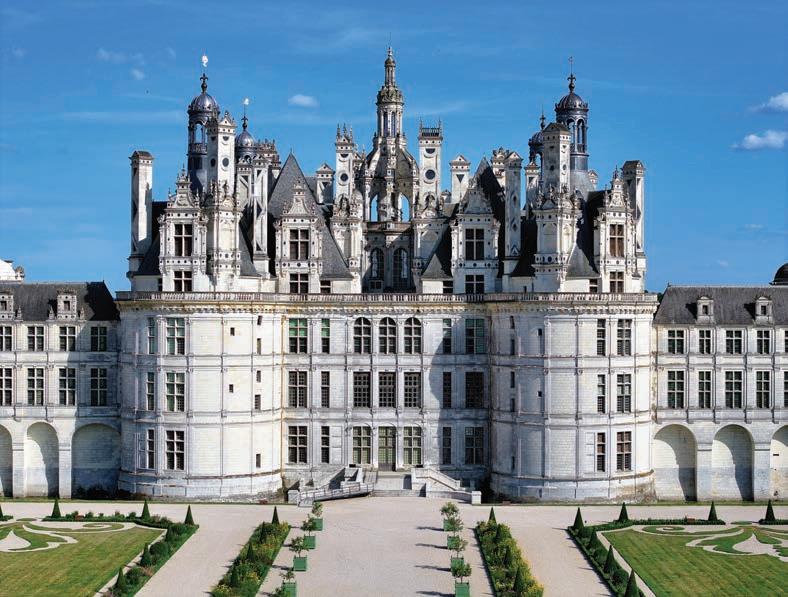
windows, and lofty ceilings rendered heating impractical. Additionally, its remote location meant that sustenance had to be transported. This meant that all food had to be brought with the group, typically numbering up to 2,000 people at a time. Furniture, wall coverings, and essentials were brought in for each hunting excursion, a logistical feat that often required disassembling and reassembling furniture.
Top: Combining medieval architecture with the new modes of construction typical of the Italian Renaissance, Chambord drew inspiration from the medieval imagination, chivalric romance and depictions of illuminated manuscripts. In accordance with the wishes of François I, Chambord springs up in the forest as an enchanted castle. Photograph
Left: In the eighteenth century the interiors of the castle were refurbished by various occupants who had the apartments fitted with woodwork, parquet floors, false ceilings and private petits cabinets.

WANDERLUST 83
Domaine National de Chambord Castle © Olivier Marchant.
Photograph Domaine National de Chambord Castle © Sophie Lloyd.
Following the death of Francis I in 1547, Chambord saw a period of neglect until the reign of Louis XIV in the 17th century. The Sun King would reside at Chambord several times in the company of his court - hosting grandiose hunting parties and festive entertainment. In the 18th century various occupants took on the task of furnishing the castle's apartments with woodwork, parquet floors, false ceilings, and private spaces known as "petits cabinets."


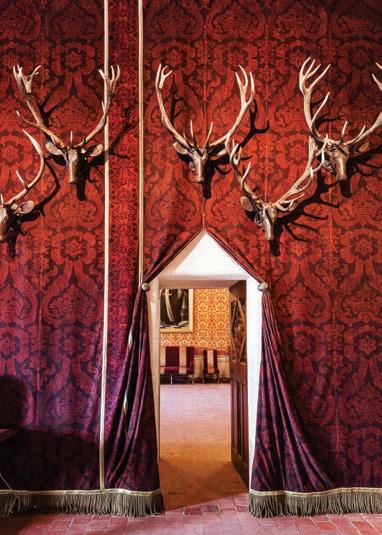
Château de Chambord has also seen unique moments in history. In the late 1700s, as the French Revolution raged, while the château was ransacked, the monument itself escaped destruction, though it would then remain deserted for decades. Then, just before the outbreak of World War II in 1939, the château played a pivotal role in safeguarding some of France's most precious works of art like the Mona Lisa and Venus de Milo.
Today, Château de Chambord has a magical fairy-tale-like appearance with an enchanting, towering presence. Featuring a magnificent 128 metre façade, Chambord boasts an intricate roofscape - Francis I wanted it to resemble the skyline of Constantinople, and the result is a stunning contrast of white stone against the sharply pointed black slate roof. The château is surrounded by a sprawling 52.5 square-kilometre wooded park and game reserve,
31-kilometer
84 WANDERLUST
enclosed by a
wall. This expansive natural setting adds to the captivating aura, putting Château de Chambord in a world beyond the ordinary, steeped in history, with the influence of Leonardo da Vinci in the air.
Above left: The castle is designed around a central architectural marvel: the double helix staircase, inspired by Leonardo da Vinci.
Photograph Domaine National de Chambord Castle © Leonard de Serres. Above right: The restored Chambord lanterns.
Photograph Domaine National de Chambord Castle © Leonard de Serres. Left: Inside Renaissance Château de Chambord.
Photography Domaine National de Chambord Castle © Sophie Lloyd.

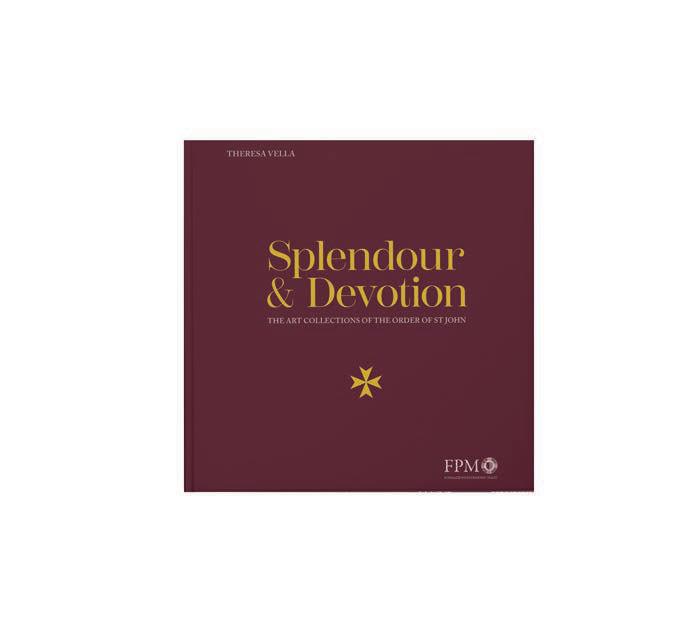

YEARS of Elegantly written and thoughtfully conceived, this lavish production is grounded in scholarly research but accessible to a wide readership. To read it is to enter a fascinating world. Splendour & Devotion e Art Collections of the Order of St John eresa Vella Specifications: 300 x 255mm | 304 pgs | Hardback | €95
Signed copies available from www.kitegroup.com.mt Kite Group, 13, Triq il-Franġiskani, Ħamrun 9993 2592
Photography: Daniel Cilia
ENIGMATIC RENAISSANCE MASTERPIECE
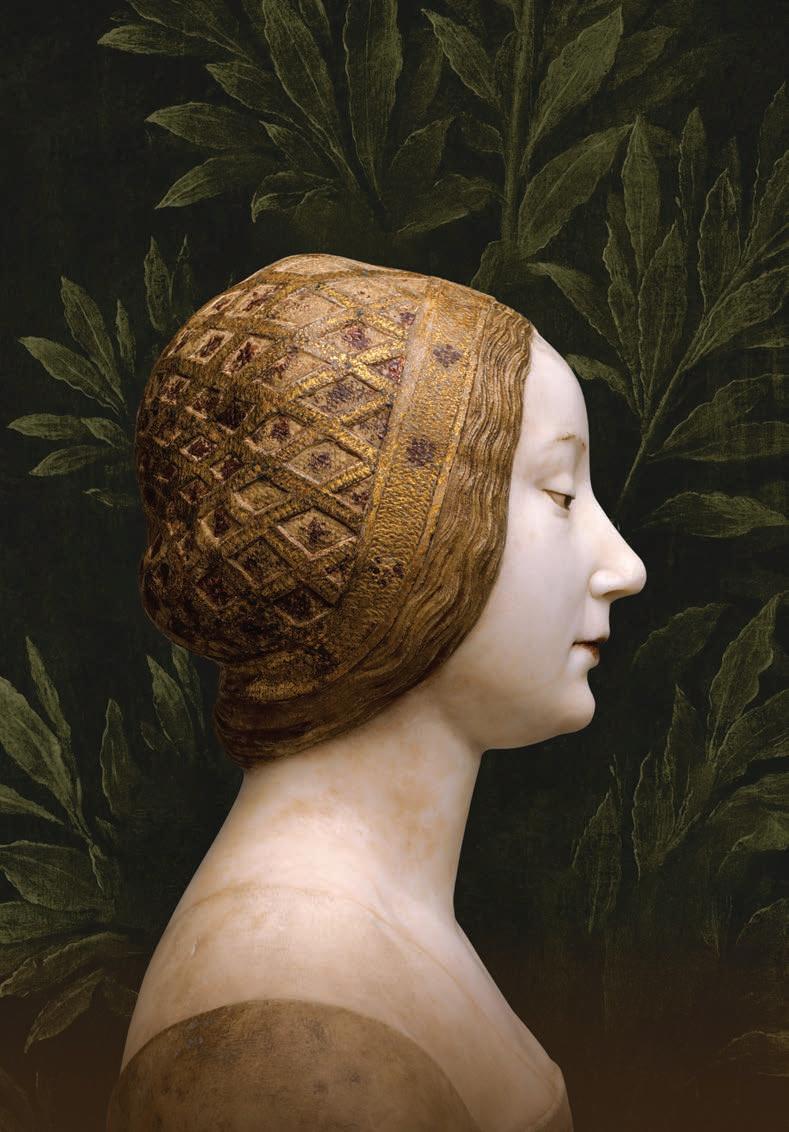
FALLing IN LOVE WITH LAURA A Mystery in Marble
The enigmatic marble busts of young women by Italian Renaissance sculptor Francesco Laurana (c.1430–1502) are a captivating mystery. People have long wondered about the identity of the sitter. Why has she averted her eyes? Does her expression suggest boredom or arrogance? Is she shy or haughty? Nine of these busts are found in various European and American museums. One is held at the Kunstkammer Vienna. It is one of the few Renaissance marble busts with colouring and among the most significant creations of fifteenth century portrait sculpture, and currently at the centerpiece of a small but spectacular exhibition, In Love with Laura –A Mystery in Marble, at the Kunsthistorisches Museum Vienna, until 15th October 2023. The exhibition also explores the possibility that that this is a portrait of the mysterious Laura, who was so deeply (but unhappily) beloved by the Italian Renaissance poet Petrarch. He addressed over 300 moving love poems to her. For the first time ever, three out of the nine busts by Laurana are on display together including two busts from the Frick Collection in New York.
ICONIC
86
This page: Francesco Laurana, Bust of a Woman, idealized portrait of Laura (?) Last third of the 15th century, polychromed and gilt marble, wax appliqués, Kunsthistorisches Museum Vienna, Kunstkammer. In Love with Laura, advertising image © KHM-Museumsverband.

OCTOBER ’ 23 MORE INFO











































































 BY MALTA’S FOREMOST WINERY.
BY MALTA’S FOREMOST WINERY.















































 Above: The Tenuta Tignanello estate is in the heart of Chianti Classico, in the gently rolling hillsides between the Greve and Pesa river valleys. It extends over an area of 319 hectares, of which about 130 are dedicated to vines. Two of the estate’s prized vineyards are on the same hillside, Tignanello and Solaia, on soils that originated from marine marlstone from the Pliocene period rich in limestone and schist. The vines benefit from hot days and cool evenings through the growing season. Tenuta Tignanello, the vineyards. Photography Mauro Puccini, courtesy Marchesi Antinori Spa.
Above: The Tenuta Tignanello estate is in the heart of Chianti Classico, in the gently rolling hillsides between the Greve and Pesa river valleys. It extends over an area of 319 hectares, of which about 130 are dedicated to vines. Two of the estate’s prized vineyards are on the same hillside, Tignanello and Solaia, on soils that originated from marine marlstone from the Pliocene period rich in limestone and schist. The vines benefit from hot days and cool evenings through the growing season. Tenuta Tignanello, the vineyards. Photography Mauro Puccini, courtesy Marchesi Antinori Spa.




































 Photography Alexey Lin.
Photography Alexey Lin.









































